Naval battles changed over time of course with advancing technology. In the bronze age, properly naval tactics were still in their infancy. Naval combat was a transposition of land combat at sea. Archers and javelineers soften the enemy until boarding allowed melee combat. During the Greek age, between asia minor, the aegean, and greece, the interlocking network of city states between the sea and mountain saw the first maritime empire. The Mediterranean, closed sea, seemed more hospitable and were used as ways to travel from Europe to Africa, and to the Middle east. After the Phoenicians, the Greeks built the first maritime empire, based on trade and war. In the Hellenistic ages, tactics were refines and ships became larger, pushing to the limit the concept of the triere and all derivatives.
In Medieval times, coastal navigation was still the norm, but the scandinavians on one side, and the Byzantines in the other, kept the flame of technology alight, until they mixed. Ship technology improved, sailing plans became more complicated and the ships much taller, with sometimes not clear distinction between civilian and military. Until the first guns were introduced in the XVth Century, naval combat did not differed that much since a millenia.
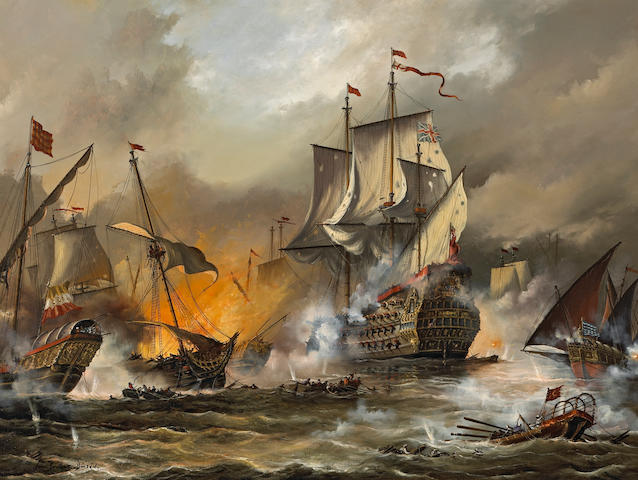
Gunpowder indeed completely turned the tables of naval combat. Confuse melee now turned into more refined tactics, to bear and use firepower the best way. Up to the XIX century, through the Renaissance and Enlightenment age, battle lines became the norm, reflecting infantry lines and volley fire on land. The old galley had its last gasp in the Baltic. Fleets became more professionnal, Navies are institutionalized by the state, rationalized, as well as ship building. Mathematics and the latest sciences are called upon to bring wooden sailing ships to the highest form of development possible.
Of course the XIXth century, the industrial age, brought not one, but a serie of groundbreaking innovations that constantly reshaped naval warfare, up to the XXth Century. For more on this topic, see the industrial era tech page.
Automated lists
- Bakumatsu & Meiji Era Ships
- Battle of Manila May, 1, 1898
- Battle of Santiago de Cuba (july, 3, 1898)
- Battle of Tsushima 1905
- Battle of Yalu (1894)
- The Battle of lissa (1866)
- The Crimean War (1853-55)
- 1st Battle of Heligoland (28 August 1914)
- Admiral Souchon’s Escape (3-8 August 1914)
- Armistice and consequences
- Battle of Cape Sarytch (18 November 1914)
- Battle of Coronel (1st November 1914)
- Battle of Elli and Lemnos (1912-13)
- Battle of Gotland (July, 2, 1915)
- Battle of Imbros (20 January 1918)
- Battle of Jutland (May 31, 1916)
- Battle of Moon Island (October 1917)
- Battle of the Falklands (8 December 1914)
- Battle of Tsingtao (August-Nov. 1914)
- Dover Strait Actions – October 1916 to April 1917
- Lake Tanganyika’s naval battles
- Operations in the Adriatic
- Otranto Strait Battle (May, 15, 1917)
- Second Battle of Heligoland (17 November 1917)
- SMS Emden’s Incredible True Odyssey
- The Antivari Action (August 14 1914)
- The Dardanelles Campaign (February-September 1915)
- The Königin Luise Event (5 August 1914)
- The Odensholm Action (August 26, 1914)
- The torpedoing of Lusitania – May 7, 1915
- Zeebruge Raid (April, 23, 1918)
- 2nd Battle of the Atlantic (1940-44)
- Battle of Hanko (1941)
- Battle of Midway (4-7 June 1942)
- Dunkirk (26 May-4 June 1940)
- Operation C3 – Herkules – The Axis planned invasion of Malta (1942)
- Operation Vado (13-14 June 1940)
- USN WW2 Amphibious Operations
⚔ Hall of fame: Greatest Naval Battles
Salamis
Cape Ecnomus
Actium
Red Cliffs
Battle of the Masts
Yamen
Lake Poyang
Lepanto
Vyborg Bay
Svensksund
Trafalgar
Sinope
Naval Battles of the Antiquity
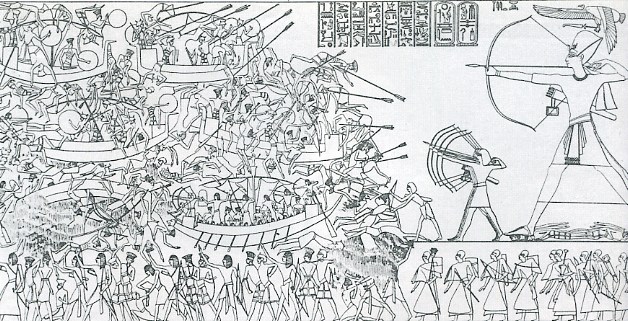
The oldest ancient naval battle is that of Kadesh, which was held between the Egyptian Ramses II and the “peoples of the sea” (mostly Assyrians, Phoenicians and other free peoples of the coast) in the Nile Delta. It is known to us both by famous and detailed bas-reliefs and a brief description of the battle dated with precision.
An Hellenistic example: Chios, 201 BC
In -201 a battle took place between the Macedonian fleet of Philip V and the coalition fleets of Rhodes and Pergamos. This battle of Chios is well known to us thanks to a detailed description of Polybius (Book XVI-I, the affairs of Macedonia, 2.1 to 7.6.):
2.1 – 2.10: “Seeing that the siege operations were unsuccessful and that the enemy was watching the coast with a large fleet of cataphracting ships, Philip was perplexed and worried about the sequel, as circumstances left him no choice He resumed the sea, contrary to the expectation of his enemies, and had expected that he would persevere in his mine-works, and the Macedonian sought above all to sail suddenly, for he was sure of winning the enemy And when he went along the coast, he arrived safely in Samos, but he was completely mistaken in his calculations, when Attalus and Theophiliscos (the navarch of the Rhodian fleet) saw him sail, and they immediately reacted.
Because, as I have said, they were convinced that Philip would stick to his original plan, but by oars they succeeded in starting the battle, To the right wing of the enemy, who went forward, and Theophiliscos to the left wing. Philip, having no longer time to flee, gave his right wing the signal of the combat by ordering him to face the enemy and to engage the action energetically. He himself, with some Lemboi, retired to the islets in the middle of the strait, to await the outcome of the battle there. The fleet which he put in line consisted of fifty-three cataphract vessels, Vessels, and two hundred small ships, Lemboi and Pristseis. He had not been able to equip the ships which were in Samos. The enemy (an Egyptian squadron disarmed). The enemy, on the other hand, had sixty-five cataphract vessels, including those of Byzantium, nine trihemolies, and three triremes.
* Or Pristis, type of unidentified vessel, near Lemboï.
** The fact that trihemolies are classified in the “non-cataphract” and less numerous than the trire seems to attest a type of “half-trire”.
3.1 – 3.14: “The ship of Attalus having engaged the combat, all those who were in the neighborhood immediately threw themselves, without waiting for the orders, one on the other.” Attalus came to give against an octere to which he carried a blow After a long battle sustained by the soldiers stationed on the deck of the enemy’s ship, he finally sank it, and Philippe’s flagship, a deer, A trihemolia having crossed its course, he struck a violent blow in the middle of the hull and remained fixed under the bench of the thranites because the pilot officer had not been able to moderate The dekere, completely paralyzed, could no longer maneuver at all, and two enemy penteris arriched on her, fastened her on both sides at the same time, and sank her with it His crew. On board was Democrates, the navarque of Philip. Towards the same moment, supernatural misadventures arrived at Dionysodoros and Deinocrates, two brothers, both of whom were navarks in the fleet of Attalus.
They had rushed against the enemy, one against a heptere, the other against an octere. Deinocrates came up against the octere and his ship received a blow above the waterline, for the prow of the enemy’s ship was very high, reaching the Macedonian ship above the water.
He could not at first disengage himself, in spite of all the efforts he made to retreat, and as the Macedonians fought with his heart, he found himself in a most perilous position. Attalus then came to his assistance, and separated the two ships by spurring that of the enemy. Deinocrates was thus saved unexpectedly, while the naval soldiers, enemies after a valiant resistance, were all massacred that the ship itself, abandoned by its crew, fell into the hands of Attalus. When Dionysodorus, having dashed on the enemy’s ship to spur it, missed his goal, and spinning alongside his opponent, lost his row of oars to starboard, while the wooden pieces supporting the towers were also broken.
As a result of this, the enemy ships surrounded him on all sides, and in the clamor and tumult, the ship of Dionysodoros was sunk with almost all its crew. The navarch himself, with two companions, succeeded in joining by swimming a trihemiolia which came to the rescue.
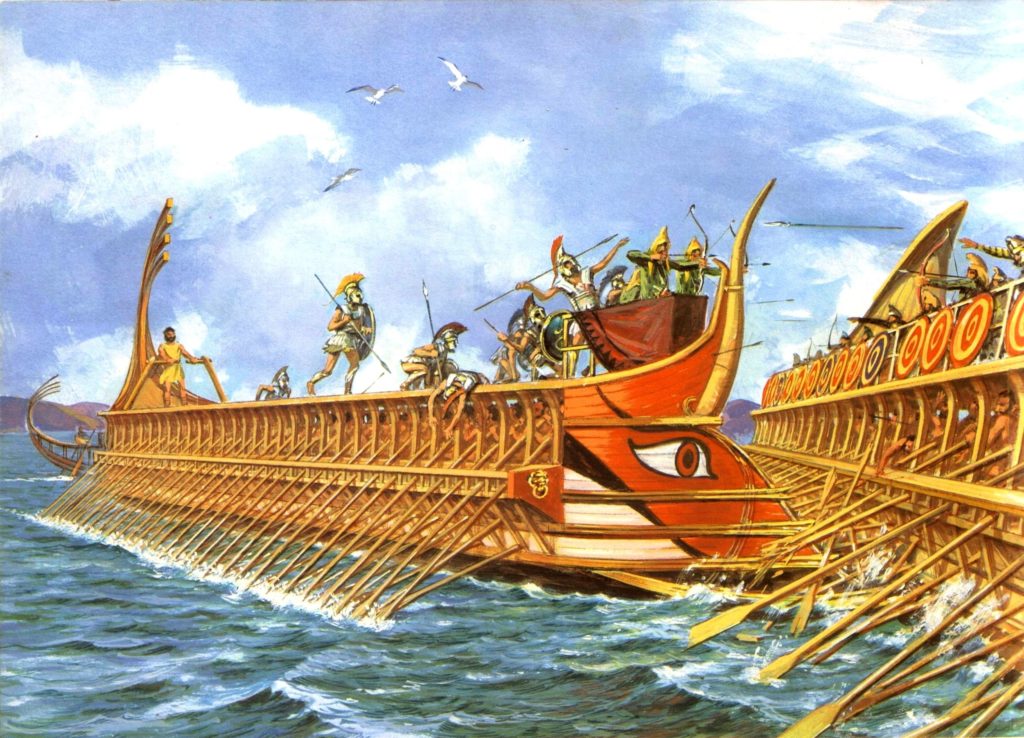
4.1 – 4.15: “Everywhere else the battle remained undecided, for if Philip outweighed the Lemboi, Attale had more cataphratic vessels, and the situation in the Macedonian right wing was such that , The outcome of the combat being still suspended, the confidence was much greater on the side of Attalus, and the Rhodians, as I have said above, were at first at the moment when they had Paired, far behind the enemy, but as their ships were much faster, they had succeeded in rejoining Philip’s rearguard, and taking first the enemy ships which were retreating, they broke their oars.
As the other Macedonian ships began to turn to help their comrades in danger, and that the last Rhodian ships, which had reached the open sea with some delay on the others, had now caught up with Theophiliscos, the two fleets lined up To face and bravely engaged the struggle, the men encouraging each other with loud cries as the trumpets sounded. If the Macedonians had not intercalated their Lemboi, between the Cataphract ships, the decision would ultimately have been obtained after a brief battle. But the lembi of Philip embarrassed the Rhodian ships in their movements, and this in several ways.
As soon as, after the first shock, their order of battle was disturbed, all the ships were caught in a confused melee. As a result, the Rhodians found themselves in a good position to make inroads through the opposing lines, then tack and, in general, to take advantage of their advantages. Indeed, the Lembi sometimes rode on their oars, which they put out of service, sometimes on their prows, and sometimes also on their stern, thus appearing the pilot officers and the rowers.
For the frontal attacks, the Rhodians had devised an ingenious process. They had their ships stung in front of them, as they were hit above the waterline, while they touched their opponents beneath, thus opening up irreparable breaches in their hulls. But in this case they seldom resorted to this procedure, as they generally endeavored to avoid collisions because of the valor displayed by the Macedonian soldiers stationed on the bridges in the fighting at the corps- To-body.
They generally preferred to sink into the enemy lines in such a way as to put the enemy vessels out of service. Then, turning back, they would return to these ships and hit them either at the stern or flank, while they were still turning. Thus they disemboweled the hull of some, or broke some of the others indispensable to the service of the vessel. They put off a great number of Macedonian ships.
5.1 – 5.9: “Three Rhodian pentères behaved in a particularly brilliant manner during the battle: The flagship bearing Theophiliscos, then the ship commanded by Philistratos, and finally the ship on which Autolycos served as pilot officer and where Nicostratos, who had gone against a Macedonian ship, left his spur planted in his hull, and sent it at the bottom with all his crew, but the ship of Autolycos was now watering by the prow, The men on board fought valiantly, but finally Autolycos, wounded, fell into the sea with his arms, and the brave soldiers of the navy again killed themselves. However, Theophiliscos had tried to bring them relief with three pentres , But as their ship was invaded by water, he did not succeed in rescuing them, but he spurred their enemy ships, whose naval soldiers were thrown overboard.
He soon found himself surrounded by a great number of enemy ships, emblems, or cataphract vessels, and in the course of a heteric struggle, lost almost all his naval soldiers, and himself received three wounds, accomplishing prodigies of audacity. He barely saved his ship with the help of Philostratos, who, having come to his assistance, had played his part in this engagement.
After rejoining his own, Theophiliscos rushed again against the enemy, for if he were physically very weakened by his wounds his valiant soul was more ardently and resolute than ever. There were now two naval battles that took place at a good distance from one another. Philippe’s right wing, continuing to advance in the direction originally fixed, was no farther from the Asiatic coast, while the left wing, which had tacked to support the rear guard, was fighting against the Rhodians Not far from Chios.
6.1 – 6.13: “Attalus, however, largely dominated the enemy’s right wing and was now approaching the islets in front of which Philippe was at anchor, awaiting the outcome of the battle. Who was on the point of sinking, after having been spurred by an enemy ship, he rushed with his two tents to assist him, and as the enemy’s ship drew back and went towards the coast, he pursued it with ardor Hoping to catch him, and observing that Attalus had diverged a great deal from his own, he threw himself in his turn with four pentères, three hemiolies, and the few lemboi he had with him. Flew, and could only throw himself on the coast in this perilous danger, and then went with the crew to take refuge at Erythrai, while Philip seized his ships and all the Royal luggage.
Had in fact had recourse to a stratagem and had all his precious stuff displayed on the bridges. So the Macedonians who first approached them with their Lemboi, seeing these heaped cuts, these purple cloaks, and all the rest to the end, abandoned the pursuit of the old men to take possession of the booty.
This enabled Attalus to arrive safe and sound in Eritrea. As for Philip, who had hitherto had everywhere and greatly undermined him, his ardor was stimulated by the mishap of Attalus. He went back to the sea and gladly opened his window to try to rally his ships, encouraging his men and assuring them that they were victors.
And these were quite tempted to believe him, seeing him thus arrive with the Royal ship of Attale in tow, they could think that the latter had perished. But Dionysodorus suspected what had happened to the King, and, hailing a signal, he rallied his ships. Thus the Pergamon fleet, rapidly regrouped, was able to gain, without being disturbed, the ports of the Asiatic coast. In this time the Macedonian ships which fought against the Rhodians, and who had long suffered, withdrew from the struggle in small groups, by appearing to go and rescue theirs. Thereupon the Rhodian ships took in tow or spilled the enemy’s boats, and then retired to Chios.”
Naval Battles list
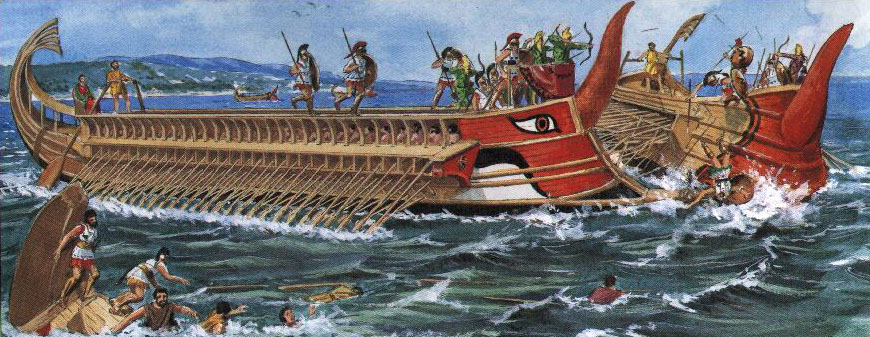
Battle of Lade (494 BC)
In the Vth century, one of the first recorded naval battles in the aegean took place between Ionia and the Persian Empire. The fleet was commanded by Dionysius of Phocaea with 353 ships (according to Herodotus), and Datis with 600 ships. Casualties and losses included 246 ships on the Ionian Greek side, 57 on the Persian side. The background was the Ionian Revolt in 494 BC. The alliance of Ionian cities and the Persian Empire under Darius the Great proved a decisive victory for the Persians.
After three years of Persian campaigning across Asia Minor without much result, a combined army navy operation was mounted and headed for the epicentre of the rebellion, at Miletus. The Ionians tried to defend Miletus by sea and the Ionian fleet gathered off Lade. The Persians at first tried to persuade some of Ionian contingents to defect, which failed until they launched the assault, at which point, the Samian fleet accepted. The latter sailed away from the battle, and being one of the major components of the fleet, this trigerred the collapse of the entire Ionian battle line. Honor was saved by a Chian contingent, that fought to the last. This was a decisive defeat which also put an end to the Ionian revolt for good. Darius later vowed to punish Athens and Eretria for their support which led to the first of the numerous campaigns against Greece.
Battle of Artemisium (480 BC)
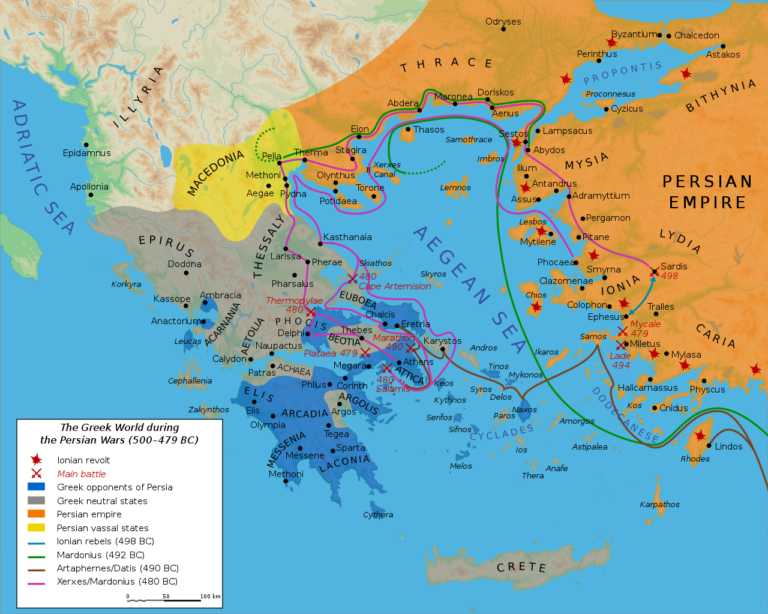
Before Salamis, this was a major naval Battle, in fact a series of naval engagements over three days at the occasion of the second Persian invasion of Greece. On land took place the battle of Thermopylae while the naval battle took place off the coast of Euboea between an alliance of Greek city-states (Sparta, Athens, Corinth…) and the Persian Empire (Xerxes I).
Following its defeat at the Battle of Marathon, the Persian King amassed a huge army and navy, famously opposed by the Athenian general Themistocles. The coalition was to famously block the pass of Thermopylae while simultaneously the fleet was to block the Straits of Artemisium with 271 triremes. More on the post about Salamis.
The Persian navy was caught in a gale off the Magnesia loosing about 1/3 of its mighty fleet of 1200 ships. After arriving at Artemisium, they sent a detachment of 200 ships around the coast of Euboea in order to trap the Greeks, caught and dispersed in another storm. For what left, a serie of actions were fought over two days and both sides lost about the same number. After the defeat at Thermopylae, the Greek fleet retreated to Salamis for another last stand.
Battle of Cumae (474 BC)
A rather foggy naval battle of lesser importance, fought between Cumae (southern Etruscan border) and the Etruscans. For the context, in 524 BC a composite army of Umbrians, Daunians, and Etruscans were defeated by the Cumae Greeks, a rice city-state in the south of Italy, called the “great greece”.
This naval battle combined a fleet of Syracuse and another of Cumae, pitted against the Etruscans. Hiero I of Syracuse was called for help by Cumae as the Etruscan fleet was considerable. Other cities of southern Italy also sent contingents to help against the Etruscan expansion into southern Italy. The Etruscan fleet was defeated in the Bay of Naples but details are not known. It was decisive enough for what the Etruscans ceased their expansion and gradually lost much of their political influence in Italy. Later the Gauls, coming from the north west, pushed back the Etruscans into a shrinking territory.
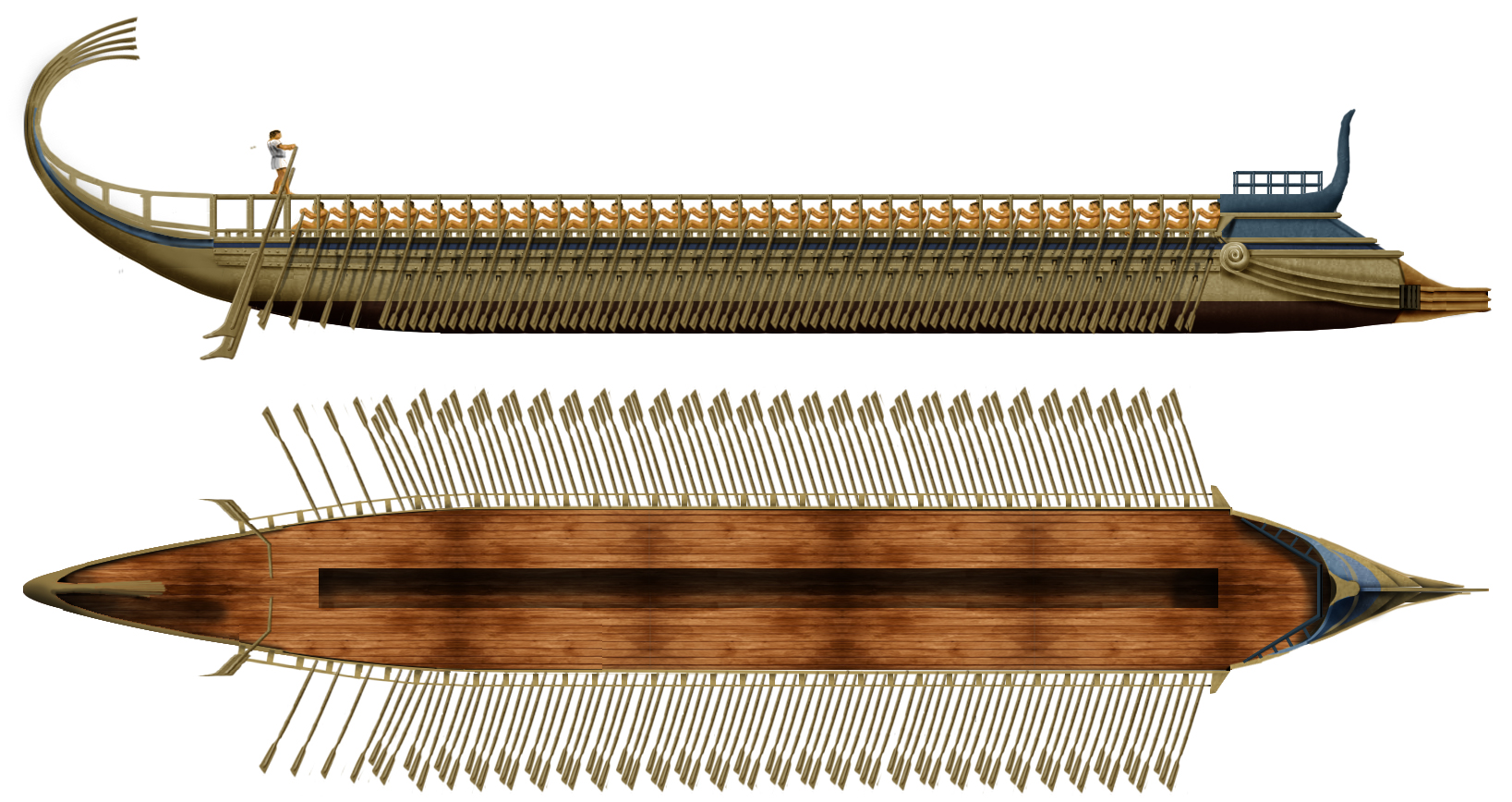
Ancient Chinese naval warfare

An Eastern Han (25–220 AD) Chinese pottery boat fit for riverine and maritime sea travel, with an anchor at the bow, a steering rudder at the stern, roofed compartments with windows and doors, and miniature sailors. In ancient China, the first known naval battles took place during the Warring States period (481–221 BC) when vassal lords battled one another. Chinese naval warfare in this period featured grapple-and-hook, as well as ramming tactics with ships called “stomach strikers” and “colliding swoopers”. It was written in the Han dynasty that the people of the Warring States era had employed chuan ge ships (dagger-axe ships, or halberd ships), thought to be a simple description of ships manned by marines carrying dagger-axe halberds as personal weapons.
The 3rd-century writer Zhang Yan asserted that the people of the Warring States period named the boats this way because halberd blades were actually fixed and attached to the hull of the ship in order to rip into the hull of another ship while ramming, to stab enemies in the water that had fallen overboard and were swimming, or simply to clear any possible dangerous marine animals in the path of the ship (since the ancient Chinese did believe in sea monsters; see Xu Fu for more info).
Qin Shi Huang, the first emperor of the Qin dynasty (221–207 BC), owed much of his success in unifying southern China to naval power, although an official navy was not yet established (see Medieval Asia section below). The people of the Zhou dynasty were known to use temporary pontoon bridges for general means of transportation, but it was during the Qin and Han dynasties that large permanent pontoon bridges were assembled and used in warfare (first written account of a pontoon bridge in the West being the oversight of the Greek Mandrocles of Samos in aiding a military campaign of Persian emperor Darius I over the Bosporus).
During the Han Dynasty (202 BC–220 AD), the Chinese began using the stern-mounted steering rudder, and they also designed a new ship type, the junk. From the late Han dynasty to the Three Kingdoms period (220–280 AD), large naval battles such as the Battle of Red Cliffs marked the advancement of naval warfare in the East. In the latter engagement, the allied forces of Sun Quan and Liu Bei destroyed a large fleet commanded by Cao Cao in a fire-based naval attack.
In terms of seafaring abroad, arguably one of the first Chinese to sail into the Indian Ocean and to reach Sri Lanka and India by sea was the Buddhist monk Faxian in the early 5th century, although diplomatic ties and land trade to Persia and India were established during the earlier Han dynasty. However, Chinese naval maritime influence would penetrate into the Indian Ocean until the medieval period.
Naval Battles of the Medieval Era
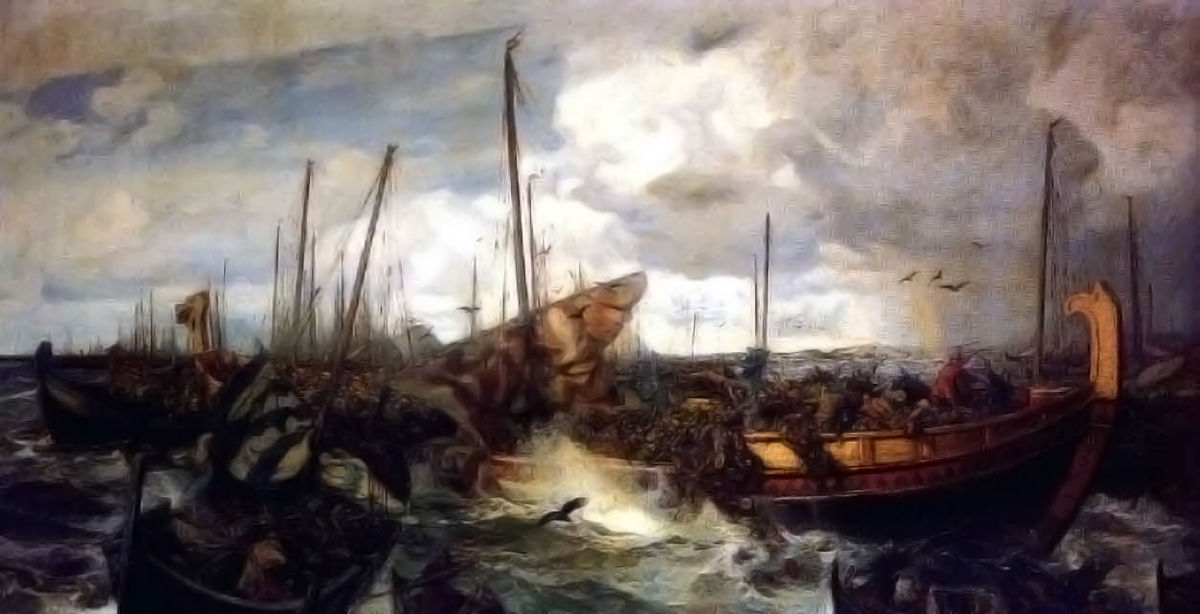
The late Middle Ages saw the development of the cogs, caravels and carracks ships capable of surviving the tough conditions of the open ocean, with enough backup systems and crew expertise to make long voyages routine. In addition, they grew from 100 tons to 300 tons displacement, enough to carry cannon as armament and still have space for cargo. One of the largest ships of the time, the Great Harry, displaced over 1,500 tons.
The voyages of discovery were fundamentally commercial rather than military in nature, although the line was sometimes blurry in that a country’s ruler was not above funding exploration for personal profit, nor was it a problem to use military power to enhance that profit. Later the lines gradually separated, in that the ruler’s motivation in using the navy was to protect private enterprise so that they could pay more taxes.
Like the Egyptian Shia-Fatimids and Mamluks, the Sunni-Islamic Ottoman Empire centered in modern-day Turkey dominated the eastern Mediterranean Sea. The Ottomans built a powerful navy, rivaling the Italian city-state of Venice during the Ottoman–Venetian War (1499–1503).
While the barbarian invasions of the 4th century and later mostly occurred by land, some notable examples of naval conflicts are known. In the late 3rd century, in the reign of Emperor Gallienus, a large raiding party composed by Goths, Gepids and Heruli, launched itself in the Black Sea, raiding the coasts of Anatolia and Thrace, and crossing into the Aegean Sea, plundering mainland Greece (including Athens and Sparta) and going as far as Crete and Rhodes. In the twilight of the Roman Empire in the late 4th century, examples include that of Emperor Majorian, who, with the help of Constantinople, mustered a large fleet in a failed effort to expel the Germanic invaders from their recently conquered African territories, and a defeat of an Ostrogothic fleet at Sena Gallica in the Adriatic Sea.
During the Muslim conquests of the 7th century, Arab fleets first appeared, raiding Sicily in 652 (see History of Islam in southern Italy and Emirate of Sicily), and defeating the Byzantine Navy in 655. Constantinople was saved from a prolonged Arab siege in 678 by the invention of Greek fire, an early form of flamethrower that was devastating to the ships in the besieging fleet. These were the first of many encounters during the Byzantine-Arab Wars.
The Islamic Caliphate, or Arab Empire, became the dominant naval power in the Mediterranean Sea from the 7th to 13th centuries, during what is known as the Islamic Golden Age. One of the most significant inventions in medieval naval warfare was the torpedo, invented in Syria by the Arab inventor Hasan al-Rammah in 1275. His torpedo ran on water with a rocket system filled with explosive gunpowder materials and had three firing points. It was an effective weapon against ships.
In the 8th century the Vikings appeared, although their usual style was to appear quickly, plunder, and disappear, preferably attacking undefended locations. The Vikings raided places along the coastline of England and France, with the greatest threats being in England. They would raid monasteries for their wealth and lack of formidable defenders. They also utilized rivers and other auxiliary waterways to work their way inland in the eventual invasion of Britain. They wreaked havoc in Northumbria and Mercia and the rest of Anglia before being halted by Wessex. King Alfred the Great of England was able to stay the Viking invasions with a pivotal victory at the Battle of Edington. Alfred defeated Guthrum, establishing the boundaries of Danelaw in an 884 treaty. The effectiveness of Alfred’s ‘fleet’ has been debated; Dr. Kenneth Harl has pointed out that as few as eleven ships were sent to combat the Vikings, only two of which were not beaten back or captured.
The Vikings also fought several sea battles among themselves. This was normally done by binding the ships on each side together, thus essentially fighting a land battle on the sea.[8] However the fact that the losing side could not easily escape meant that battles tended to be hard and bloody. The Battle of Svolder is perhaps the most famous of these battles.
As Arab power in the Mediterranean began to wane, the Italian trading towns of Genoa, Pisa, and Venice stepped in to seize the opportunity, setting up commercial networks and building navies to protect them. At first the navies fought with the Arabs (off Bari in 1004, at Messina in 1005), but then they found themselves contending with Normans moving into Sicily, and finally with each other. The Genoese and Venetians fought four naval wars, in 1253–1284, 1293–1299, 1350–1355, and 1378–1381. The last ended with a decisive Venetian victory, giving it almost a century to enjoy Mediterranean trade domination before other European countries began expanding into the south and west.
In the north of Europe, the near-continuous conflict between England and France was characterised by raids on coastal towns and ports along the coastlines and the securing of sea lanes to protect troop–carrying transports. The Battle of Dover in 1217, between a French fleet of 80 ships under Eustace the Monk and an English fleet of 40 under Hubert de Burgh, is notable as the first recorded battle using sailing ship tactics. The battle of Arnemuiden (23 September 1338), which resulted in a French victory, marked the opening of the Hundred Years War and was the first battle involving artillery.[9] However the battle of Sluys, fought two years later, saw the destruction of the French fleet in a decisive action which allowed the English effective control of the sea lanes and the strategic initiative for much of the war.
Overview of naval Medieval battles
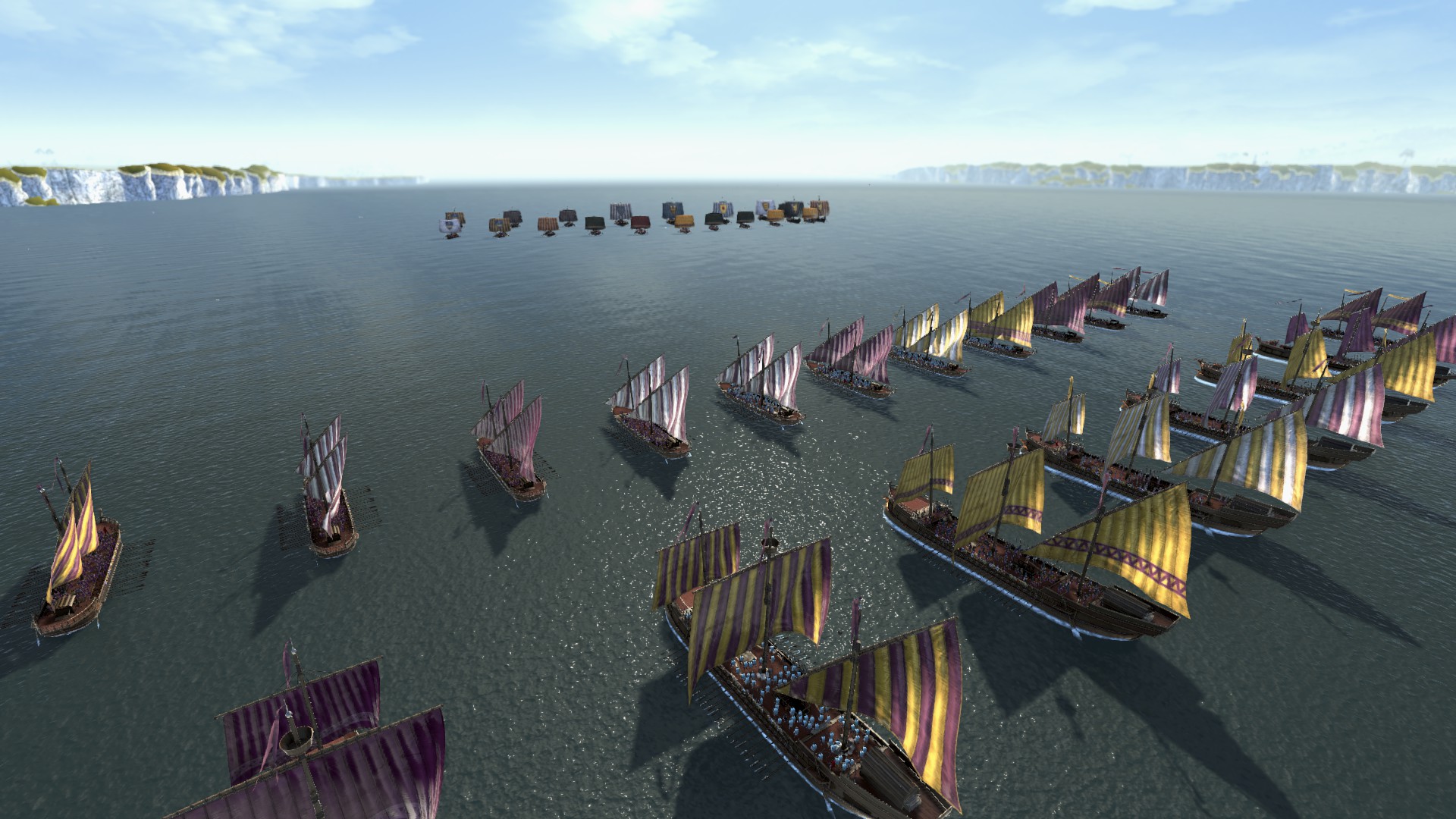
5th century AD
- 456 – Romans under Flavius Ricimer defeat Vandals near Corsica
- 461 Cartagena – Vandals destroy a newly built West Roman fleet
- 468 Cape Bon – Vandals defeat East and West Romans under Basiliscus
6th century
- 551 Sena Gallica – The Byzantines defeat the Ostrogoths
7th century
- 655 Battle of the Masts – Arabs under Uthman defeat Byzantines under Constans II
- 663 August Battle of Baekgang – Tang China and Silla defeat Yamato Japan and Baekje
- 676 Battle of Gibeolpo – Silla defeat Tang China
- 677 or 678 First Arab siege of Constantinople – Byzantines defeat Arabs (first use of “Greek fire”)
- 697? – Greeks under John defeat Arabs
- 698 Carthage – Arabs defeat Greeks under John at Carthage
- 698 – Imperial Constantinopolitan fleet defeats Cibyrrhaeot rebels
8th century
- 717, September 3 Second Arab siege of Constantinople – Byzantines under Leo III the Isaurian defeat Arabs
- 718, Spring Second Arab siege of Constantinople – Byzantines under Leo III defeat Arabs
- 719, Dalriadan civil war resulted in a conflict between two opposing groups of curraghs, mentioned in the Senchus Fer n-Alban
- 727 – Byzantine central imperial fleet destroys provincial Helladic and Cyclades fleets under Agallianos Kontoskeles.
- 746 Battle of Keramaia – The Cibyrrhaeots annihilate the Egypt-based fleet of the Umayyad Caliphate
9th century
- 806? – Moors defeat Franks under Hadumar near Corsica
- 807 – Franks under Burchard (a lieutenant of Charlemagne) defeat Moors at Sardinia
- 813 – Byzantines defeat Arabs
- 813 – Franks under Irmingar defeat Moors near Majorca
- 820 – Arabs defeat Franks near Sardinia
- 822 – Constantinople: Byzantine central imperial fleet defeats rebel provincial fleets during the revolt of Thomas the Slav
- 829 – Battle of Thasos: Cretan Saracens defeat Byzantines
- 841 – Arabs defeat Venetian squadron near Taranto
- 849 Ostia – Italian city-states vs Muslims off southern Italy
- 851 Sandwich – Athelstan defeats Viking fleet near Kent
- c.872/3 Battle of Kardia – Byzantine admiral Niketas Ooryphas defeats a fleet of Cretan Saracens under the renegade Photios.
- c.873/9 Battle of the Gulf of Corinth – Byzantine admiral Niketas Ooryphas defeats a fleet of Cretan Saracens and kills their commander, the renegade Photios.
- 880 Battle of Cephalonia – Byzantines under Nasar destroy Aghlabid fleet
- Battle of Stelai (also Punto Stilo or Milazzo) – Byzantines under Nasar destroy Aghlabid fleet
- 885 – Frisians defeat Vikings
- 888 Battle of Milazzo – Aghlabids defeat Byzantines
10th century
- 906 – Byzantines under Himerios defeat Arabs on St. Thomas’ Day
- 912 – Battle of Chios (912) – Syrian-Cilician fleet defeats Byzantine squadron under Himerios
- 932 – Battle of Lang-shan Jiang
- 941 – Rus’-Byzantine War – Byzantine fleet under Theophanes destroys Kievan Rus’ fleet under Igor near Bosporus Strait
- 938 – First Battle of Bach Dang River – Vietnamese defeat Southern Han fleet
- 956 – Tunisian fleet destroyed by Christians near Mazara
- 958 – Tunis vs Christians in Messina Strait
- 965 – Battle of the Straits – Fatimid fleet destroys Byzantine fleet under Niketas Abalantes at the Straits of Messina
- 975 – Song forces defeat Tang forces
- 981 Second Battle of Bach Dang – Vietnam defeats Chinese Song forces
- 998 – Venetians under Orseolo defeat Narentan pirates
11th century
- 1000 September 9 Swold – Swedes and Danes defeat Norwegians
- 1004 – Venetians under Pietro Orseolo II defeat Arabs at Messina
- 1005 – Pisans defeat Arabs at Messina
- 1024 – Lemnos – Byzantines defeat Rus’ fleet in the Lemnos Island
- 1026 The Helgeå – Danes under Ulf Jarl defeat Swedes and Norwegians under Anund Jacob and Olaf II Haraldsson (Olaf the Stout) in southern Sweden
- 1032 – A joint Byzantine-Ragusan squadron defeats a Muslim corsair fleet in the Adriatic
- 1032 – According to one hypothesis, battle at Iron Gate mentioned in Russian chronicles was a naval battle, where Novgorod fleet tries to reach Tallinn Bay, but is defeated by Estonians.
- 1035–1036 – Last Arab corsair raids against the Aegean islands are repulsed by the Byzantines
- 1043 Rus’-Byzantine War – Byzantines defeat Rus’ squadron in the Bosporus
- 1062 Niså – Norwegians under Harald Hardrada defeat Danes in Kattegat
- 1081 Dyrrhachium – Venetian-Byzantine fleet defeats Normans near Durazzo, Albania
- 1084 – Normans under Robert Guiscard (20 vessels?) defeat Venetians or Byzantines in a series of battles off Albania/Corfu
- 1123 Ibelin – Venetian fleet disperses Fatimid Egyptian fleet near Jaffa
- 1137 Bigano – Venetians defeat Normans/Roger II of Sicily at Trani, Italy
- 1149 Cape Malea – Venetians and Byzantine Greeks defeat Normans
- 1153 Siege of Ascalon – Venetians defeat Fatimid Arabs near Tel Aviv
- 1156 January – Celtic ships defeat Viking squadron north of Scotland
- 1161 Nov 16 Tangdao – Song forces defeat Jin forces during the Jin–Song wars
- Nov 26-27 Caishi – Song forces defeat Jin forces
- 1177 – Venetians and the Vatican defeat Genoese and Pisans
- 1183 November 17 Mizushima – Battle off coast of Shikoku
- 1184 June 15 Fimreite – King Sverre Sigurdsson of Norway defeats and kills rival King Magnus Erlingsson in the Sognefjord
- 1185 March 22 Yashima – Battle off coast of Shikoku
- April 25 Dan-no-ura – Decisive victory for Minamoto clan off present-day Shimonoseki, Yamaguchi, Japan, ends Genpei War
- November 7 – Byzantines under Alexios Branas defeat Normans at Demetrias (Volos), Greece
12th century
13th century
- 1213 May 30 and 31 Damme – English under William Longsword sink most of fleet of France’s King Philip II in the harbor of Damme
- 1217 August 24 Dover (South Foreland) – The “Fight off Sandwich”. Fleet of English Hubert and Burgh defeat French fleet of Eustace the Monk off Dover. There were actually 2 battles – this describes the 2nd
- 1241 May 3 (First) Meloria – Pisans under Ansaldo de Mari defeat Genoese
- 1258 June 25 – Battle of Acre – Venetian fleet defeats Genoese fleet off Acre
- 1263 – Settepozzi – A Venetian fleet of 38 ships under Gilberto Dandolo defeats a joint Byzantine-Genoese fleet of 48 ships off the Peloponnese
- 1264 – Saseno – Genoese defeat Venetians
- 1266 Trapani – Venetians defeat Genoese
- c. 1273/1275 – Demetrias – Byzantine fleet defeats coalition of Lombard and Venetian lords of Euboea and Crete
- 1278 July 25 – Algeciras – Castilians vs Morocco and Granada
- Before 1279 – Conrad Lancia defeats Muslim fleet near Tunisia
- 1279 March 19 Yamen – Yuan Dynasty defeats Song Dynasty
- 1282 October 11 – Peter de Queralt defeats Angevin fleet near Reggio di Calabria
- October 14 – Peter de Queralt defeats Angevin fleet near Nicotera
- 1283 July 8 Malta – Aragonese-Sicilians under Roger of Lauria defeat Angevins in Grand Harbour, Malta
- 1284 June 5 Gulf of Naples – Aragonese-Sicilians under Roger of Lauria defeat Neapolitans and capture Charles of Salerno (later Charles II of Naples)
- August 6 (Second) Meloria – Genoese utterly destroy the Pisan fleet near Tuscany, Italy
- 1285 August? (possibly mid-September) – 11 Catalan galleys defeat 25 French galleys under Guillaume de Lodève at Rosas
- September 4 (probably) Les Formigues (Las Hormigas) – Aragonese-Sicilians under Roger of Lauria defeat French under di Mari and de Orreo near Barcelona
- 1287 June 23 The Counts – Aragonese-Sicilians under Roger of Lauria defeat Angevins near Naples
- 1288 Third Battle of Bach Dang – Vietnamese defeat Mongols
- 1294 Laiazzo – Genoese defeat Venetians near Laiazzo
- 1298 September 9 Curzola – Genoese fleet under Lamba Doria defeats Venetians under Andrea Dandolo
- 1299 July 4 Cape Orlando – Angevins under Roger of Lauria defeat Sicilians under d’Oria off northern Sicily
- 1300 June 14 Ponza – Angevins under Roger of Lauria defeat Sicilians under d’Oria near Naples
14th century
- 1304 August 18 (2 days) Zierikzee – French fleet under Genoese admiral Renier Grimaldi destroys Flemish fleet
- 1319 July 23 Chios – Knights Hospitaller and Genoese of the Lordship of Chios score a crushing victory over an Aydinid fleet
- 1338 September 23 Arnemuiden – Philip VI of France beats English fleet of Edward III of England off the coast of Zeeland. It was the first naval battle using artillery.
- 1340 June 24 Sluys – Edward III of England beats Franco-Genoese fleet of Philip VI of France off the coast of Flanders and gains control of the English Channel
- 1342 Guernsey
- 1350 August 29 (Old Style) L’Espagnols-sur-Mer – 50 English ships under Edward III and the Black Prince defeat 40 Castilian ships
- 1352 Bosporus – Genoese under Paganino Doria vs Venetians, Byzantine Greeks and Aragonese in Bosporus Strait
- 1353 August 29 La Loiera – Venetians and Aragonese defeat Genoese near Sardinia
- 1354 Sapienza Genoese under Paganino Doria defeat Venetians under Niccolò Pisani in the southern Peloponnese
- 1363 August 30-October 4 Lake Poyang – Mings under Zhu Yuanzhang defeat Hans under Chen Youliang
- 1372 June 22 and 23 La Rochelle – Castilian fleet defeats English fleet near La Rochelle
- 1378 – Venetians under Vettor Pisani defeat Genoese near Cape d’Anzio
- 1379 May 7 Pola – Genoese under Luciano Doria defeat Venetians under Vittore Pisani near Pula
- 1380 June Chioggia – Venetians under Andrea Contarini defeat Genoese
- 1387 March 24 and 25 Margate – English fleet under Richard, Earl of Arundel defeat Franco-Castilian-Flemish wine fleet under Sir Jean de Bucq
- 1403 October 7 Modon – Genoese fleet under the French Marshal Boucicaut is defeated by the Venetians under Carlo Zeno
- 1416 May 29 Gallipoli – Venetians defeat Ottoman Turks
- August 15 (OS?) Harfleur – English defeat French near Harfleur
- 1417 – English defeat French and Genoese
- 1419 – Castilians defeat English-Hanseatic fleet at La Rochelle
- 1427 September Battle of Wieringen – Burgundian fleet defeats fleet of Jacqueline of Bavaria
- 1427 – Battle of the Echinades – Byzantines defeat fleet of Carlo I Tocco
- 1431 – Venetians and Florentines under Pietro Loredano and Paolodi Vanni Rucellai defeat Genoans under Francesco Spinola
- 1448 San Vincenzo – Neapolitans defeat Florentines
- 1453 April 12 – Fall of Constantinople – Turks attack Byzantine vessels defending Constantinople
- April 20 – Fall of Constantinople – Turks fail to prevent Genoese supply ships reaching Constantinople
- 1457 August – 3 Polish ships defeat Danish-Livonian fleet
- 1463 September 15 Battle of Vistula Lagoon – Polish and Prussian Confederation victory over Teutonic Order fleet
- 1476 August 13 – French defeat Genoese near Cape St Vincent
- 1478 – 11 Portuguese ships defeat and capture a Castilian fleet of 35 ships at the Battle of Guinea
- 1495 May 2 – Battle of Rapallo – Genoese fleet under Francesco Spinola defeats French fleet under de Miolans, all French ships are captured.
- 1499 August 12, 20, 22 and 25 Zonchio (Sapienza/Navarino/First Lepanto) – Turks under Daoud Pasha defeat Venetians under Antonio Grimani and are able to capture the fortress of Lepanto
- 1500 August Modon (Second Lepanto) – Turks under Kemal Reis defeat Venetians
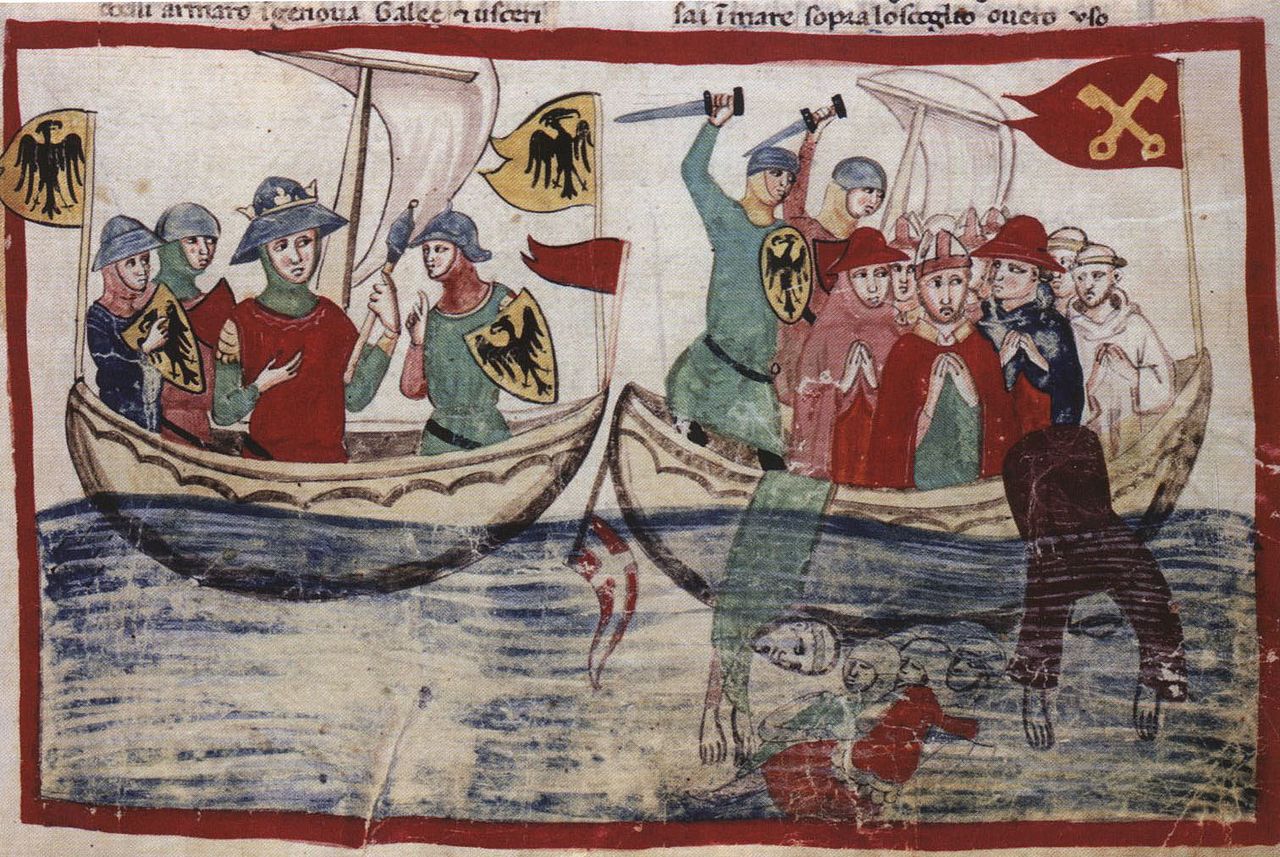
15th century Battles
Naval Battles in Asia
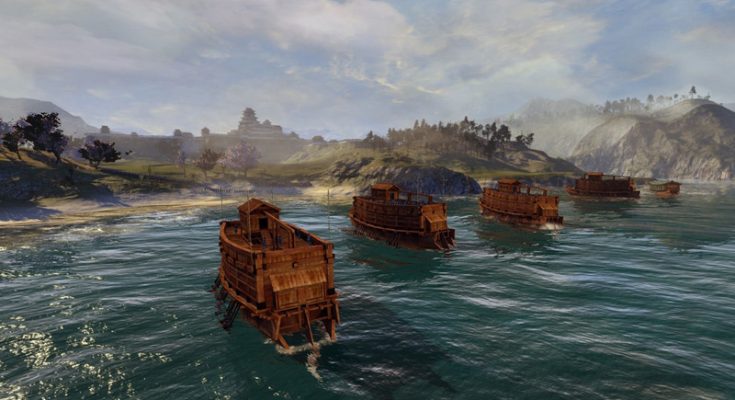
The Sui (581–618) and Tang (618–907) dynasties of China were involved in several naval affairs over the triple set of polities ruling medieval Korea (Three Kingdoms of Korea), along with engaging naval bombardments on the peninsula from Asuka period Yamato Kingdom (Japan).
The Tang dynasty aided the Korean kingdom of Silla (see also Unified Silla) and expelled the Korean kingdom of Baekje with the aid of Japanese naval forces from the Korean peninsula (see Battle of Baekgang) and conquered Silla’s Korean rivals, Baekje and Goguryeo by 668. In addition, the Tang had maritime trading, tributary, and diplomatic ties as far as modern Sri Lanka, India, Islamic Iran and Arabia, as well as Somalia in East Africa.
Indian Ocean naval warfare
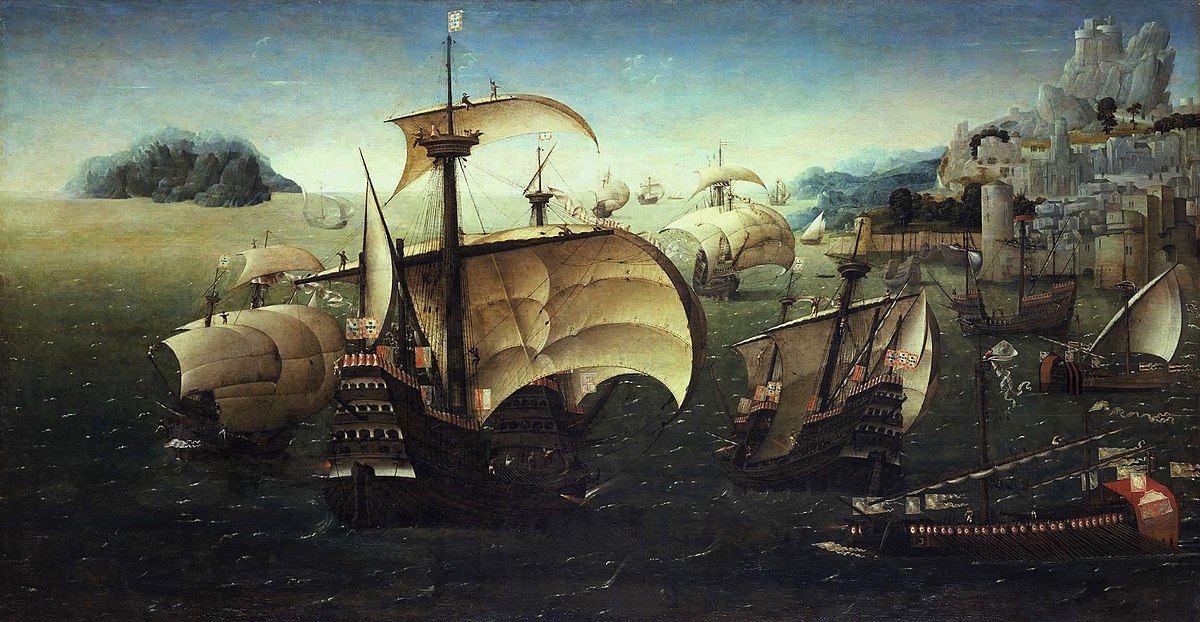
From the Axumite Kingdom in modern-day Ethiopia, the Arab traveller Sa’d ibn Abi-Waqqas sailed from there to Tang China during the reign of Emperor Gaozong. Two decades later, he returned with a copy of the Quran, establishing the first Islamic mosque in China, the Mosque of Remembrance in Guangzhou. A rising rivalry followed between the Arabs and Chinese for control of trade in the Indian Ocean. In his book Cultural Flow Between China and the Outside World, Shen Fuwei notes that maritime Chinese merchants in the 9th century were landing regularly at Sufala in East Africa to cut out Arab middle-men traders.
The Chola dynasty of medieval India was a dominant seapower in the Indian Ocean, an avid maritime trader and diplomatic entity with Song China. Rajaraja Chola I (reigned 985 to 1014) and his son Rajendra Chola I (reigned 1014–42), sent a great naval expedition that occupied parts of Myanmar, Malaya, and Sumatra. The Cholas were the first rulers noted to have a naval fleet in the Indian subcontinent; there are at least two evidences to cite use of navies. Narasimhavarman Pallava I transported his troops to Sri Lanka to help Manavarman to reclaim the throne. Shatavahanahas was known to possess a navy that was widely deployed to influence Southeast Asia, however the extent of their use is not known.
Some argue that there is no evidence to support naval warfare in a contemporary sense. Others say that ships routinely carried bands of soldiers to keep pirates at bay. However, since the Arabs were known to use catapults, naptha, and devices attached to ships to prevent boarding parties, one may conclude that Chola navies not only transported troops but also provided support, protection, and attack capabilities against enemy targets.
Full size replica of Borobudur ship of the 8th century AD. This one had gone to expedition to Ghana in 2003–2004, reenacting the Srivijayan and Medang navigation and exploration.
In Nusantara archipelago, large ocean going ships of more than 50 m in length and 4–7 m freeboard are already used at least since the 1st century AD, contacting West Africa to China. Srivijaya empire since the 7th century AD controlled the sea of the western part of the archipelago. The Kedukan Bukit inscription is the oldest record of Indonesian military history, and noted a 7th-century Srivijayan siddhayatra expedition led by Dapunta Hyang Sri Jayanasa. He was said to have brought 20,000 troops, including 200 seamen and 1,312 foot soldiers. The 10th century Arab account Ajayeb al-Hind (Marvels of India) gives an account of invasion in Africa by people called Wakwak or Waqwaq, probably the Malay people of Srivijaya or Javanese people of Medang in 945-946 CE.
They arrived in the coast of Tanganyika and Mozambique with 1000 boats and attempted to take the citadel of Qanbaloh, though eventually failed. The reason of the attack is because that place had goods suitable for their country and for China, such as ivory, tortoise shells, panther skins, and ambergris, and also because they wanted black slaves from Bantu people (called Zeng or Zenj by Arabs, Jenggi by Javanese) who were strong and make good slaves.Srivijaya remained a formidable sea power until the 13th century. It is theorized that the main warship of the Srivijaya was an outrigger ship called akin to Borobudur ship.
Mongol naval sea power
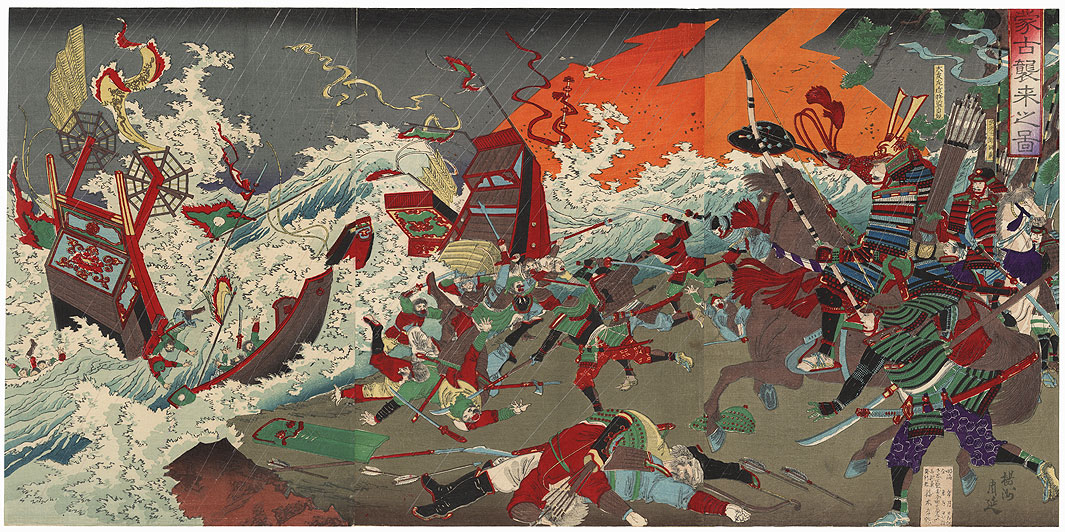
In 1293, Mongol Yuan Dynasty launched an invasion to Java. The Yuan sent 1000 ships and 20,000-30,000 soldiers, but ultimately defeated in the land by surprise attack, forcing the army to fall back to the beach. In the coast, Javanese junk ships already attacked Mongol ships. After all of the troops had boarded the ships on the coast, the Yuan army battled the Javanese fleet. After repelling it, they sailed back to Quanzhou. Gunung Butak inscription from 1294 mentioned that naval commander Aria Adikara intercepting a further Mongol invasion and successfully defeating it before landing in Java. Although with only scarce information, travellers passing the region, such as Ibn Battuta and Odoric of Pordenone, however noted that Java had been attacked by the Mongols several times, always ending in failure. After those failed invasions, Majapahit empire quickly grew and became the dominant naval power in the 14-15th century.
The usage of cannons in the Mongol invasion of Java, led to deployment of cetbang cannons by Majapahit fleet in 1300s and subsequent near universal use of the swivel-gun and cannons in the Nusantara archipelago. The main warship of Majapahit navy was the jong. Jong were large transport ships which could carry 500-800 tons of cargo and 200-1000 people, 70-180 meter in length. The exact number of jong fielded by Majapahit is unknown, but the largest number of jong deployed in an expedition is about 400 jongs, when Majapahit attacked Pasai, in 1350. In this era, even to the 17th century, the Nusantaran naval soldiers fought on a platform on their ships called Balai and performed boarding actions. Majapahit navy used breech-loading cannon called cetbang to counter this type of fighting, firing scattershots against the enemy personnel.
In the 12th century, China’s first permanent standing navy was established by the Southern Song dynasty, the headquarters of the Admiralty stationed at Dinghai. This came about after the conquest of northern China by the Jurchen people (see Jin dynasty) in 1127, while the Song imperial court fled south from Kaifeng to Hangzhou. Equipped with the magnetic compass and knowledge of Shen Kuo’s famous treatise (on the concept of true north), the Chinese became proficient experts of navigation in their day. They raised their naval strength from a mere 11 squadrons of 3,000 marines to 20 squadrons of 52,000 marines in a century’s time.
Employing paddle wheel crafts and trebuchets throwing gunpowder bombs from the decks of their ships, the Southern Song dynasty became a formidable foe to the Jin dynasty during the 12th–13th centuries during the Jin–Song Wars. There were naval engagements at the Battle of Caishi and Battle of Tangdao. With a powerful navy, China dominated maritime trade throughout South East Asia as well. Until 1279, the Song were able to use their naval power to defend against the Jin to the north, until the Mongols finally conquered all of China. After the Song dynasty, the Mongol-led Yuan dynasty of China was a powerful maritime force in the Indian Ocean.
The Yuan emperor Kublai Khan attempted to invade Japan twice with large fleets (of both Mongols and Chinese), in 1274 and again in 1281, both attempts being unsuccessful (see Mongol invasions of Japan). Building upon the technological achievements of the earlier Song dynasty, the Mongols also employed early cannons upon the decks of their ships.
While Song China built its naval strength, the Japanese also had considerable naval prowess. The strength of Japanese naval forces could be seen in the Genpei War, in the large-scale Battle of Dan-no-ura on 25 April 1185. The forces of Minamoto no Yoshitsune were 850 ships strong, while Taira no Munemori had 500 ships.
In the mid-14th century, the rebel leader Zhu Yuanzhang (1328–1398) seized power in the south amongst many other rebel groups. His early success was due to capable officials such as Liu Bowen and Jiao Yu, and their gunpowder weapons (see Huolongjing). Yet the decisive battle that cemented his success and his founding of the Ming dynasty (1368–1644) was the Battle of Lake Poyang, considered one of the largest naval battles in history.
In the 15th century, the Chinese admiral Zheng He was assigned to assemble a massive fleet for several diplomatic missions abroad, sailing throughout the waters of the South East Pacific and the Indian Ocean. During his maritime missions, on several occasions Zheng’s fleet came into conflict with pirates. Zheng’s fleet also became involved in a conflict in Sri Lanka, where the King of Ceylon traveled back to Ming China afterwards to make a formal apology to the Yongle Emperor.
The Ming imperial navy defeated a Portuguese navy led by Martim Affonso in 1522. The Chinese destroyed one vessel by targeting its gunpowder magazine, and captured another Portuguese ship.[26][27] A Ming army and navy led by Koxinga defeated a western power, the Dutch East India Company, at the Siege of Fort Zeelandia, the first time China had defeated a western power. The Chinese used cannons and ships to bombard the Dutch into surrendering.
In the Sengoku period of Japan, Oda Nobunaga unified the country by military power. However, he was defeated by the Mōri clan’s navy. Nobunaga invented the Tekkosen (large Atakebune equipped with iron plates) and defeated 600 ships of the Mōri navy with six armored warships (Battle of Kizugawaguchi). The navy of Nobunaga and his successor Toyotomi Hideyoshi employed clever close-range tactics on land with arquebus rifles, but also relied upon close-range firing of muskets in grapple-and-board style naval engagements. When Nobunaga died in the Honnō-ji incident, Hideyoshi succeeded him and completed the unification of the whole country. In 1592, Hideyoshi ordered the daimyōs to dispatch troops to Joseon Korea to conquer Ming China.
The Japanese army which landed at Pusan on 12 April 1502 occupied Seoul within a month. The Korean king escaped to the northern region of the Korean peninsula and Japan completed occupation of Pyongyang in June. The Korean navy then led by Admiral Yi Sun-sin defeated the Japanese navy in consecutive naval battles, namely Okpo, Sacheon, Tangpo and Tanghangpo. The Battle of Hansando on 14 August 1592 resulted in a decisive victory for Korea over the japanese navy. In this battle, 47 japanese warships were sunk and other 12 ships were captured whilst no Korean warship was lost. The defeats in the sea prevent the Japanese navy from providing the Japanese army with appropriate supply.
Yi Sun-sin was later replaced with Admiral Won Gyun, whose fleets faced a defeat. The Japanese army, based near Busan, overwhelmed the Korean navy in the Battle of Chilcheollyang on 28 August 1597 and began advancing toward China. This attempt was stopped when the reappointed Admiral Yi, won the battle of Myeongnyang.
The Wanli Emperor of Ming China sent military forces to the Korean peninsula. Yi Sun-sin and Chen Lin continued to successfully engage the Japanese navy with 500 Chinese warships and the strengthened Korean fleet. In 1598, the planned conquest in China was canceled by the death of Toyotomi Hideyoshi, and the Japanese military retreated from the Korean Peninsula. On their way back to Japan, Yi Sun-sin and Chen Lin attacked the Japanese navy at the Battle of Noryang inflicting a heavy damages, but Chinese top official Deng Zilong and the Korean commander Yi Sun-sin were killed in a Japanese army counterattack. The rest of the Japanese army returned to Japan by the end of December. In 1609, the Tokugawa shogunate ordered the abandonment of warships to the feudal lord. The Japanese navy remained stagnant until the Meiji period.
In Korea, the greater range of Korean cannons, along with the brilliant naval strategies of the Korean admiral Yi Sun-sin, were the main factors in the ultimate Japanese defeat. Yi Sun-sin is credited for improving the Geobukseon (turtle ship), which were used mostly to spearhead attacks. They were best used in tight areas and around islands rather than the open sea. Yi Sun-sin effectively cut off the possible Japanese supply line that would have run through the Yellow Sea to China, and severely weakened the Japanese strength and fighting morale in several heated engagements (many regard the critical Japanese defeat to be the Battle of Hansan Island). The Japanese faced diminishing hopes of further supplies due to repeated losses in naval battles in the hands of Yi Sun-sin. As the Japanese army was about to return to Japan, Yi Sun-sin decisively defeated a Japanese navy at the Battle of Noryang.
Naval Battles of the Renaissance

Although they were sorely defeated in the Battle of Lepanto (1571) by the Holy League, the Ottomans soon rebuilt their naval strength, and afterwards successfully defended the island of Cyprus so that it would stay in Ottoman hands. However, with the concurrent Age of Discovery, Europe had far surpassed the Ottoman Empire, and successfully bypassed their reliance on land-trade by discovering maritime routes around Africa and towards the Americas.
The first naval action in defense of the new colonies was just ten years after Vasco da Gama’s epochal landing in India. In March 1508, a combined Gujarati/Egyptian force surprised a Portuguese squadron at Chaul, and only two Portuguese ships escaped. The following February, the Portuguese viceroy destroyed the allied fleet at Diu, confirming Portuguese domination of the Indian Ocean.
In 1582, the Battle of Ponta Delgada in the Azores, in which a Spanish-Portuguese fleet defeated a combined French and Portuguese force, with some English direct support, thus ending the Portuguese succession crisis, was the first battle fought in mid-Atlantic.
In 1588, Spanish King Philip II sent his Armada to subdue the English fleet of Elizabeth, but Admiral Sir Charles Howard defeated the Armada, marking the rise to prominence of the English Royal Navy. However it was unable to follow up with a decisive blow against the Spanish navy, which remained the most important for another half century. After the war’s end in 1604 the English fleet went through a time of relative neglect and decline.
The Battle of the Saintes fought on 12 April 1782 near Guadeloupe
In the 16th century, the Barbary states of North Africa rose to power, becoming a dominant naval power in the Mediterranean Sea due to the Barbary pirates. The coastal villages and towns of Italy, Spain and Mediterranean islands were frequently attacked, and long stretches of the Italian and Spanish coasts were almost completely abandoned by their inhabitants; after 1600 Barbary pirates occasionally entered the Atlantic and struck as far north as Iceland.
According to Robert Davis as many as 1.25 million Europeans were captured by Barbary pirates and sold as slaves in North Africa and the Ottoman Empire between the 16th and 19th centuries. These slaves were captured mainly from seaside villages in Italy, Spain and Portugal, and from farther places like France, England, the Netherlands, Ireland and even Iceland and North America. The Barbary pirates were also able to successfully defeat and capture many European ships, largely due to advances in sailing technology by the Barbary states. The earliest naval trawler, xebec and windward ships were employed by the Barbary pirates from the 16th century.
From the middle of the 17th century competition between the expanding English and Dutch commercial fleets came to a head in the Anglo-Dutch Wars, the first wars to be conducted entirely at sea. Most memorable of these battles was the raid on the Medway, in which the Dutch admiral Michiel de Ruyter sailed up the river Thames, and destroyed most of the British fleet. This remains to date the greatest English naval defeat, and established Dutch supremacy at sea for over half a century. The English and Dutch wars were also known for very few ships being sunk, as it was difficult to hit ships below the water level; the water surface deflected cannonballs, and the few holes produced could be patched quickly. Naval cannonades caused more damage by casualties to the men and damage to the sails than sinking of ships.
Later age of sale – Battles list
Early 14th Cent.
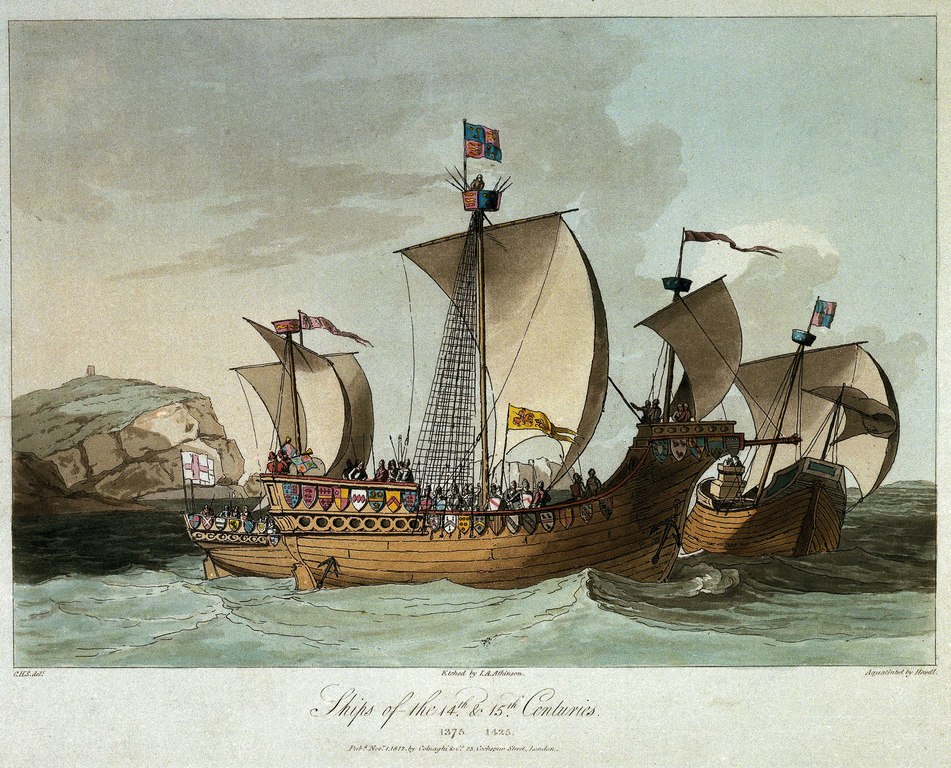
- 1509 February 3 Diu – Portugal’s Indian viceroy defeats a combined Egyptian-Gujarat Sultanate fleet off Gujarat, India, and controls spice trade
- 1510 – Maltese under Prégent de Bidoux defeat Venetians
- 1512? – Genoese under Andrea Doria defeat Moors at Algiers
- 1512 August 10 St Mathieu – English defeat French off Brest; Regent and Marie la Cordelière sunk
- 1521 Battle of Tunmen – Ming Chinese defeat Portuguese
- 1522 Battle of Xicaowan – Ming Chinese defeat Portuguese
- 1526 – Swedes and Lübeckers defeat pirate fleet
- 1529 – Ottoman Turks under Khair-ad-Din (Barbarossa) defeat Spanish
- 1535 early June – 20 Swedes/Danes/Prussians defeat 9 Lübeck ships
- 1535 June? – Swedes/Danes/Prussians defeat 10 Lübeck ships at Fyen
- 1538 September 28 Preveza – Ottoman Turk fleet under Khair-ad-Din defeats Spanish-Venetian-Papal fleet
- 1541 – Tsuruhime led an army into naval battle and drove the Ōuchi Yoshitaka into the open sea.
- 1545 July 18 and 19 The Solent – French attack English off Portsmouth; Mary Rose sinks
- August 15 – English fight French off Portsmouth
- 1549 early August (?) – English defeat French near Channel Islands
- 1552 Ponza – Ottoman Turks under Sinan Pasha defeat Genoese under Andrea Doria off western Italy
- 1555 August 11 – Bloody and inconclusive melée between French privateers and a Dutch merchant fleet off Calais
- 1558 – Portuguese fight English and French off Guinea
- July 13 – English under Count Egmont defeat French under Marshal de Thermes off Gravelines
- 1560 May 11 Djerba – Turkish galleys defeat Christian force near Djerba, Tunisia
Northern Seven Years War (1563–70)
- 1563 Action of 30 May: Swedes capture three Danes before war is declared.
- Action of 11 September: Inconclusive [skirmish?] between Danes/Lübeckers and Swedes.
- 1564 Action of 30 May: Swedes under Bagge [clash with?] Danes/Lübeckers under Trolle.
- Action of 12 July: A Swedish captain blows up his ship after a Danish attack.
- Action of 12 August: Swedes under Klas Horn defeat Danes under Herluf Trolle, southeast of Öland.
- 1565: Action of 4 June – An indecisive battle between Danes/Lübeckers and Swedes near Buchow.
- Action of 7 July: Swedes defeat Danes/Lübeckers between Bornholm and Rügen.
- 1566: Action of 26 July: Swedes defeat Danes/Lübeckers between Öland and Gotland.
- 1568: Swedish fleet captures several Polish corsairs and drives off remainder.
- 1568 September 23: Spanish under Martin Enriquez defeat English under Hawkins at San Juan de Ulúa, Mexico Offsite link
- 1570: English under Burrough and Hodsdon defeat Danes in the Baltic Sea
- July 15: Turkish galliots under Uluch Ali defeat Maltese galleys under Saint-Clement near Gozo
- 1571: January – Venetians under Marco Querini defeat Turks near Famagusta, Cyprus
- October 7, 1571: Lepanto – Christian coalition decisively defeats Ottoman Turks in a large galley fight off western Greece
- 1572 August 7 and 10 – Venetians under Colonna vs Turks under Kilitch Ali between Cervi and Cerigo and near Cape Matapan
- 1572 September/October – Several skirmishes between Spanish/Venetians and Turks
- 1573 April 17 Flushing – Sea Beggars defeat Spanish under Sancho d’Avila
- April 22 Borsele – Sea Beggars beat back a Spanish fleet under d’Avila
- >May 26 Haarlemmermeer – Spanish under Bossu defeat Sea Beggars
- October 11 Zuiderzee – Sea Beggars under Cornelis Dirkszoon defeat Spanish under Bossu
- 1574 January 29 Oosterschelde – Sea Beggars under Willem Boisot defeat Spanish under Luis de Resquesens
- May 30 Battle of lillo – Sea Beggars under Boisot defeat a Spanish fleet
- June – Swedes capture 3 Lubeckers plus 15 merchantmen
- 1576 August and 1578 Kizugawaguchi – Blockade efforts in Siege of Ishiyama Honganji, just off Osaka, Japan
- 1582 July 26 Battle of Terceira (Battle of Ponta Delgada) – Spanish under Alvaro de Bazán defeat French, Portuguese, Dutch and English under Filippo Strozzi in the Azores
- 1582 July 27 Battle of Vila Franca Alvaro de Bazán wins a second battle at the Azores in as many days.
- 1583? Maltese under Avogadro vs Turks
- 1583 August 3 – Venetians defeat Maltese under Avogadro between Cerigotto and Cape Spada
- 1585 April – Maltese galleys defeat and capture Turkish sailing ship
- Nguyen Lord navy defeats Shirahama Kenki pirate fleet.
- 1586 – English under Edward Wilkinson vs Spanish and Maltese under Pedro de Gamboa y Leyva at Pantellaria
- 1588 July and August – Defeat of the Spanish Armada off southern England
- September – Spanish Armada in Ireland
- 1589 – English Armada
- 1591 about June 13 – English vs Spanish under Diego de la Ribera
- Battle of Flores – Spanish repel English near the Azores
- 1592 May 7 Okpo – Korean navy under Yi Sun-sin defeats Japanese navy under Todo Takatora.
- May 29 Sacheon – Korean Navy defeats Japanese with the Turtle Ship.
- August 14 Hansan Island – Korean navy defeats Japanese fleet in the bay of Hansan island.
- November 1 Busan – Korean Naval demonstration to Japanese navy at the Busan bay. However, they could not occupy Busan.
- 1595 about late June – Maltese vs Bizertans
- 1595–96 – Spanish defeat English raiding/invasion expeditions of the Spanish Main led by Drake and Hawkins
- 1597 July 15 or August 28 Chilchonryang – Japanese Navy in conjunction with the Japanese army, defeats the Korean Navy, led by Won Gyun.
- October 26 Myeongnyang – 13 Korean ships under Yi Sun-sin defeats 330 Japanese ships.
- – Bizertans vs Genoese and Romans
- – Spanish defeat the English Islands Voyage near the Azores.
- 1598 December 16 Battle of Noryang – Chinese Admiral Chen Lin and Korean Admiral Yi Sun-sin heavily damage more than 100 Japanese ship, however, 150 Japanese ship succeeds in retreating.
- 1600 December 14 – Action of December 14 Dutch vs Spanish at Manila
17th century Naval battles
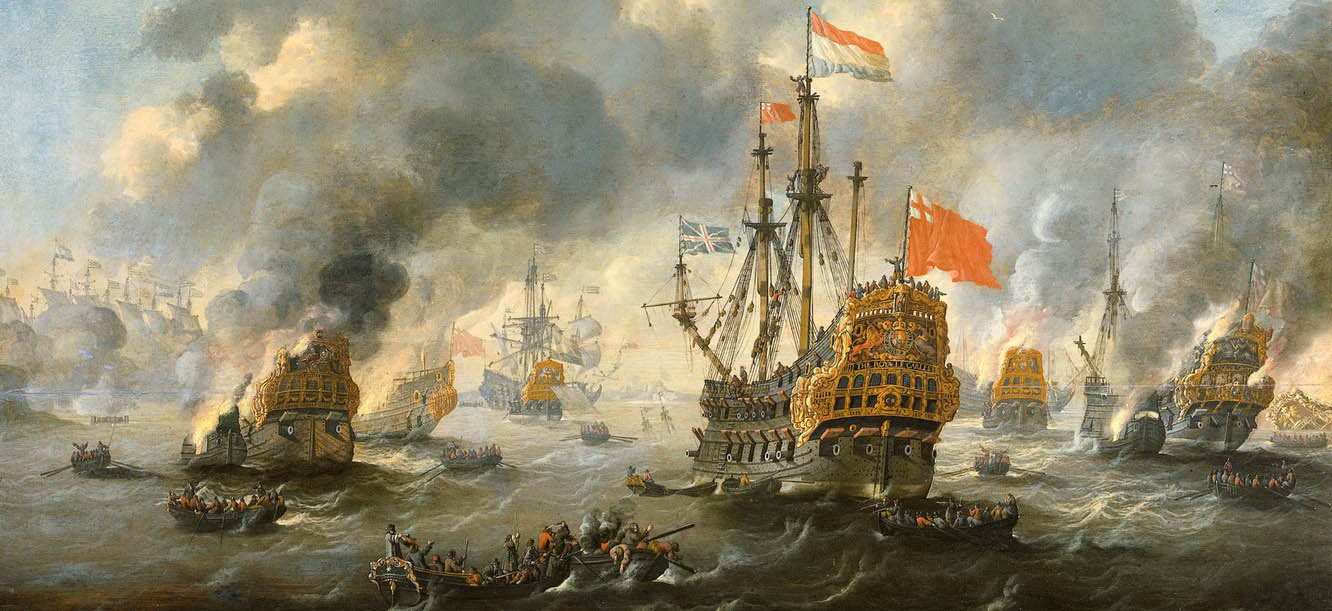
- 1601 December 27 Bantam – Dutch defeat Portuguese in Bantam Bay
- 1602 October 3 Sluis – Dutch under Jacob van Duivenvoorde defeat Spanish under Frederik Spinola
- 1603 May 26 Sluis – Dutch under Joos de Moor beat back Spanish under Frederik Spinola
- ?? 1603 October – Tuscan galleys defeat Tunisians
- 1604 October – Tuscans defeat Tunisians
- 1605 – Dutch fleet under Willem Haultain attacks and partly destroys a Spanish fleet of transport ships near Dover
- 1605 November Attack on Salinas de Araya – Spanish under Luis Fajardo defeat a fleet of Dutch smugglers and privateers
- 1606 June or October Battle of Cape St. Vincent – Spanish under Luis Fajardo defeat Dutch under Willem Haultain
- 1606 August 17 Cape Rachado – Indecisive action between a Dutch fleet under Cornelis Matelief de Jonge and a Portuguese fleet near Malacca
- September 21 Second battle of Cape Rachado – Dutch under Cornelis Matelief de Jonge destroy Portuguese ships
- 1607 April 25 Gibraltar – Dutch under Jacob van Heemskerk destroy a Spanish fleet
- October 20 – Tuscans under Beauregard defeat Turkish trade fleet
- 1609 about May – French under Beaulieu vs Tunisians
- June 29 – Spanish-French raid on La Goulette, Tunisia
- – Venetians defeat Turks near Paxos
- (late)? – Turks under Khalil defeat French under Fressinet near Cyprus
- (late)? – Turks vs French under Beaulieu
- 1610 August 21 – Tuscans vs Turks
- October 10 – Tuscans vs Turks
- 1611 August (end)? – Minor action between Danes and Swedes in Kalmar Sound
- 1612 May 23 or 25 – Sicilian-Neapolitan galley fleet defeats Tunisians at La Goulette
- November 29–30 Swally – British East India Company fleet defeats Portuguese fleet near Surat, India
- 1613 August 29 – Sicilians under de Aragon defeat Turkish trade fleet
- 1615 January 20–? (Old Style) – English defeat Portuguese in mainly minor skirmishes
- July 17 and 18 – Spanish vs Dutch (same as next?)
- – Dutch under Spilbergen defeat Spanish under de Pulgar near Valdivia, Peru
- 1616 January – Spanish vs ?
- about March? – Spanish under Ribera defeat Tunisians at La Goulette
- April 29 – Tuscans under Inghirami defeat Turks near Euboea
- July 14–16 – Spanish under Ribera defeat Turks in the first regular action between galleys and sailing ships in the Mediterranean
- July – Spanish versus Dutch
- about October (possible engagement) – Neapolitans/Sicilian galleys defeat larger Turkish galley fleet
- 1617 April 13 – Spanish under Ribera vs Venetians
- June 12 – Minor skirmish between Neapolitans/Sicilians and Venetians
- Playa Honda – Dutch defeat Spanish
- November 19 and 20 – Inconclusive battle between Sicilians and Venetians
- 1618 June 24 – Venice hires Dutch ships and fights Spanish
- July 2 and 3 – Dutch under Moy Lambert and Spanish under Vidazabal defeat Algerines
- December 23–28 – English vs Dutch near Jakarta
- 1619 January 18 and 19 – Maltese vs Algerians near Malta
- March 1 – English vs Dutch near Jakarta
- May 31 – Dutch defeat French at the mouth of the Vilaine River
- – English defeat Portuguese
- 1620 May 11 – Venetians under Nani defeat Spanish under Ribera
- June 26 – Tuscans defeat Bizertans
- December 28 – English (East India Company) defeat Portuguese at Cape Jask
- 1622 July 13–14 – English and Dutch defeat Portuguese near Mozambique
- October – French vs Rochellais (Huguenot) rebels near La Rochelle
- Dutch ships under Joachim Swartenhondt escorting a convoy repel a Spanish squadron near Gibraltar
- 1622 – English naval bombardment of Algiers
- 1624 October 3 – A combined squadron of fifteen Neapolitan (Spain), Tuscan, and Papal galleys defeat a squadron of six Algerian ships on the island of San Pietro, near Sardinia
- 1625 January – French Rochellais rebels capture French fleet at Blavet
- February 1 and 3 – Portuguese defeat English and Dutch
- June 26 – Bizertans defeat Maltese near Syracuse, Sicily
- September 15 – French under Soubise defeat hired Dutch ships near Rochelle
- 1626? – French with hired English and Dutch ships defeat Huguenot fleet near Rochelle
- 1626 late – Danes defeat Dunkirkers
- 1627 November 28 Oliwa – Poles defeat Swedes
- 1628 July 31 – Dutch ships under Pieter Ita attack and capture 2 Spanish treasure ships
- June 21 – English defeat Venetians/French at Scanderoon
- September 9 Dutch squadron under Piet Hein attacks and captures Spanish treasure fleet
- September 29 – French defeat English near La Rochelle
- 1629 August 20 – Dutch under Piet Heyn defeat Dunkirkers off Scotland; Heyn is killed
- September 16 – Swedes defeat Holy Roman Empire near Wismar
- 1630 September 4–8 – Danes force a retreat of Hanseatic ships in Elbe River
- 1631 September 12 – Undecided encounter between a Dutch and a Spanish/Portuguese fleet off Pernambuco
- September 12–13 The Slaak – Dutch Zeeland fleet under Marinus Hollare defeats Spanish invasion fleet
- 1633 July 7 to October 22 Battle of Liaoluo Bay – Ming China defeats an allied fleet of Dutch East India Company and Chinese pirates, one company’s vessel burnt and one captured by the Chinese, most of pirates’ vessels sunk or captured
- 1634 about early May – Maltese galleys defeat Turkish vessels at Zante
- July 19 – Maltese galleys under Valdina defeat Tripolitans
- – Maltese under Villages defeat Turks
- – Maltese privateers defeat Turkish galleys
- 1635 August 21 – Dunkirk squadron under Jacob Collaart (see Dunkirkers) defeat Dutch guardships and captures 60 fishing trawlers
- August 25 – Dunkirk frigates under Jacob Collaart defeats Dutch escort capturing 24 fishing trawlers
- about September 25 – Spanish defeat Dutch West India Company convoy
- 1636 early – Dutch Zeeland squadron under Johan Evertsen defeats Dunkirk fleet under Jacob Collaart
- 1637 February – 8 Spanish under Miguel de Horna defeat Dutch convoy and escort near Cape Lizard and capture 17 merchant ships
- Spanish convoy commanded by Lope de Hoces captures 32 enemy ships in the English Channel on its return voyage to Spain.
- 1638 about March 26 – Spanish under Lope de Hoces defeat and captures Dutch convoy
- June – Maltese galleys defeat Tripolitan sailing ships near Calabria
- September- French defeat Spanish in galley fight near Genoa
- August 7 – Venetians under Capello defeat Algerians at Corfu
- August 22 – French under de Sourdis destroy Spanish galleons under Lope de Hoces at Guetaría
- 1639 February 19 – Dutch under Maarten Tromp defeat a Dunkirk fleet under Miguel de Horna
- September 17–19 Calais – Running fight between Dutch under Maarten Tromp and Spanish under Antonio de Oquendo who seeks shelter at The Downs
- September 30 Mormugão – Dutch defeat Portuguese near Goa
- October 31 Battle of the Downs – Dutch under Tromp defeat Spanish under Antonio de Oquendo in the English Channel
- end December – Spanish under Miguel de Horna defeat stronger French force
- 1640 January 12–17 Pernambuco – Dutch fleet under Willem Loos defeats Spanish\Portuguese fleet under Dom Fernando de Mascarenhas
- June 15 – Dunkerquers defeat Dutch in the Shetland Isles
- July? – French under Maillé Brézé defeat Spanish under Don Gomez de Sandoval
- 1641 – French under de Sourdis defeat Spanish
- May 17 and 18 1641 – Spanish defeat French near Pensacola
- September 1 and 2 1641 – Spanish under Pietersen defeat French and Portuguese
- November 4 1641 – Dutch under Gijssels defeated by Spanish at Cape St Vincent
- 1642 end of June, 2 day battle – French under Maillé Brézé defeat Spanish under Ciudad Real near Barcelona
- October – Portuguese defeat Spanish the Fleet
- 1643 August – French defeat the Spanish Armada
Naval Battles of the Enlightenment era
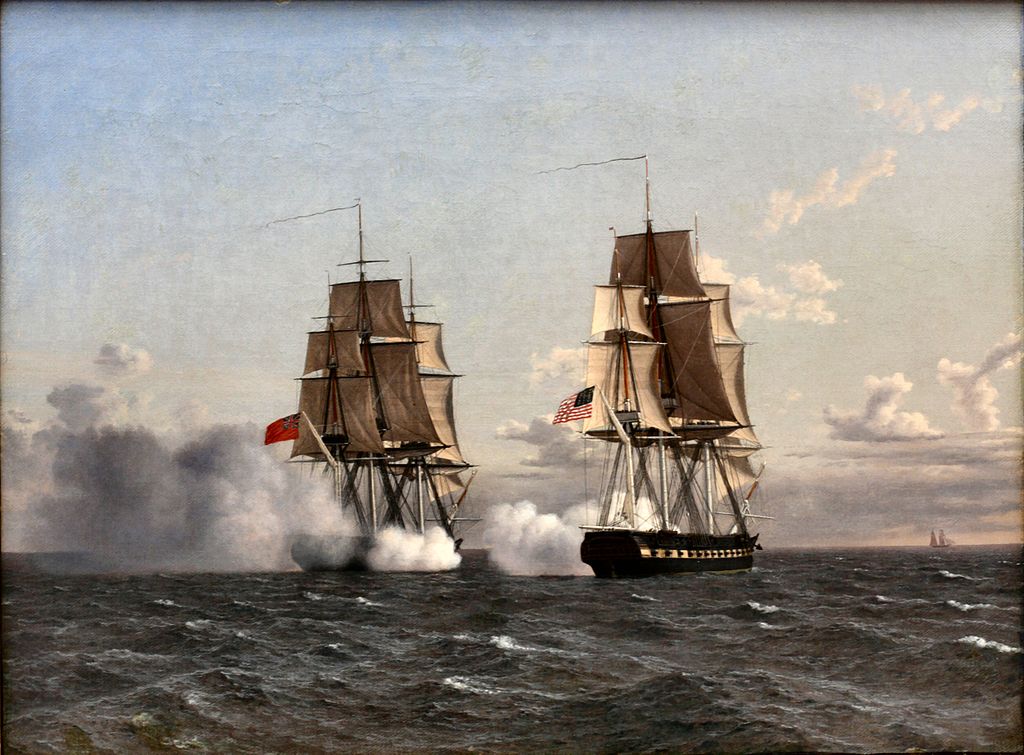
The 18th century developed into a period of seemingly continuous international wars, each larger than the last. At sea, the British and French were bitter rivals; the French aided the fledgling United States in the American Revolutionary War, but their strategic purpose was to capture territory in India and the West Indies – which they did not achieve. In the Baltic Sea, the final attempt to revive the Swedish Empire led to Gustav III’s Russian War, with its grande finale at the Second Battle of Svensksund. The battle, unrivaled in size until the 20th century, was a decisive Swedish tactical victory, but it resulted in little strategical result, due to poor army performance and previous lack of initiative from the Swedes, and the war ended with no territorial changes.
Even the change of government due to the French Revolution seemed to intensify rather than diminish the rivalry, and the Napoleonic Wars included a series of legendary naval battles, culminating in the Battle of Trafalgar in 1805, by which Admiral Horatio Nelson broke the power of the French and Spanish fleets, but lost his own life in so doing.
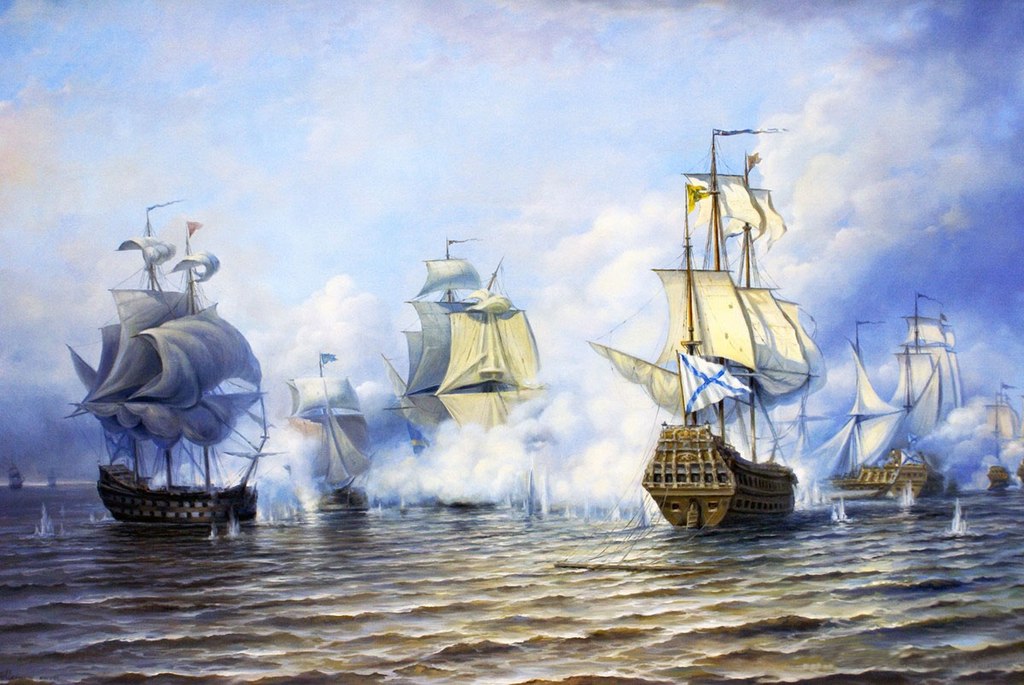
Battles list
Danish-Swedish War (1643–45)
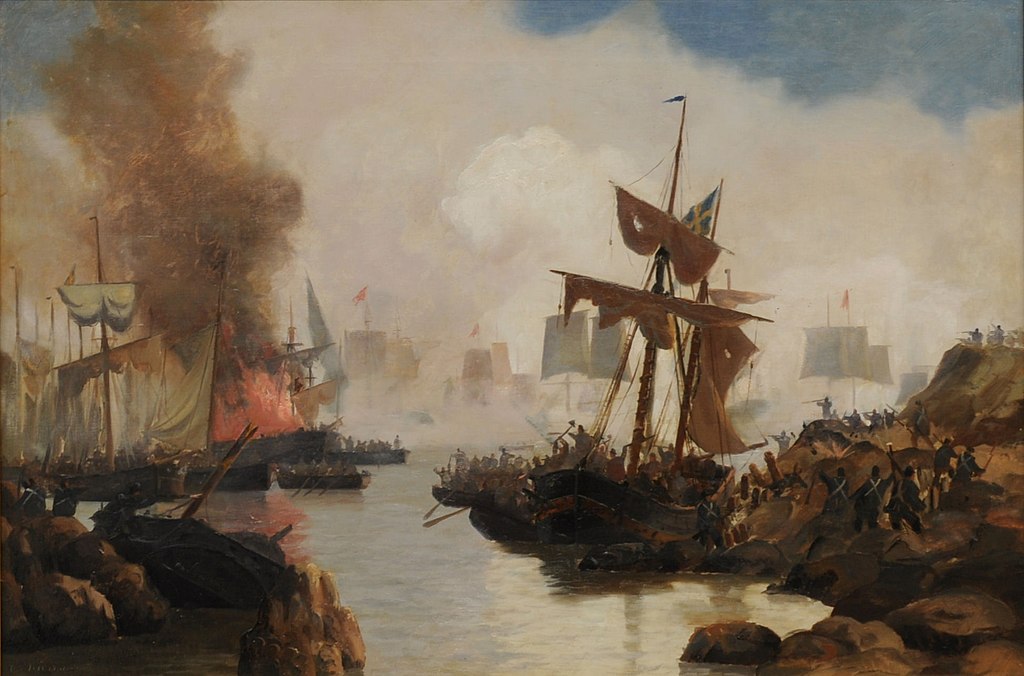
- 1644 May 16 – Danes defeat Dutch ships which have been hired to support Sweden
- May 25 – Danes get slightly the better of 33 hired Dutch ships
- July 1 Colberger Heide (Colberg Heath) – Danish and Swedish fleets fight an inconclusive battle off NE Germany
- July 7 – Danes defeat Swedes in small battle
- August 10 – Dutch fleet under Thijsen brushes past Danish fleet under King Christian IV in Kjoge Bay, Denmark
- October 13 – Femern, Germany – Combined Swedish/Dutch fleet badly defeats Danish fleet
Cretan War (1645–69)
- 1644 September 28 – Maltese galleys defeat Turkish sailing ships near Rhodes; their subsequent stay in Venetian-held Crete provoked the outbreak of war
- 1645 September 28 or 29 – Combined Christian fleet tries and fails to retake Canea (Chania) in Crete, from the Ottomans
- October 1 – Christians vs Turks near Canea, Crete
- 1646 May 26 – Venetians defeat Turkish attempt to break their blockade of the Dardanelles.
- August 14 – Inconclusive fight between Christians and the Ottoman fleet anchored at Chania Bay, Crete
- 1647 January 27 – The Ottoman fleet of 45 galleys attacks the ship of the Venetian admiral Tommaso Morosini. Both Morosini and the Ottoman admiral, Kara Musa Pasha, are killed. After suffering significant casualties, the Turks are driven off by the arrival of the remaining Venetian fleet.
- August 25 – Inconclusive skirmish between Christians and Turks
- September 9 – Inconclusive skirmish between Christians and Turks
- 1649 May 6 – Minor battle between Venetians and Turks
- May 12 Focchies – Venetians defeat large Turkish fleet near western Turkey
- July 15 – Venetians vs Turks near Candia, Crete
- July 18 – Venetians defeat Turks near Candia
- 1651 July 8 and 10 – Venetians under Mocenigo defeat Turks
- 1654 April – Maltese privateers defeat Turks near Rhodes
- May 16 – Turks under Murad defeat Venetians under Giuseppe Delfino in Dardanelles
- June 21 – Turks retreat after skirmish with Venetians west of Milos
- 1655 June 21 – Venetians under Lazaro Mocenigo defeat Turks under Mustapha in Dardanelles
- 1656 June 26 and 27 – Venetians and Maltese under Lorenzo Marcello defeat Turks under Chinam Pasha in Dardanelles
- 1657 May 3 – Venetians defeat Algerines
- May 18 – Venetians under Lazaro Mocenigo defeat Turks and Algerines at Suazich
- July 17–19 – Venetians, Maltese and Papal forces under Lazaro Mocenigo defeat Turks in Dardanelles
- 1658 May 19 – Venetians under Contarini defeat Turks between Imbros and the Dardanelles
- 1659 August 26 (or 27?) – Venetians under Contarini vs Turks
- 1660 between May 26 and June 12 – Slight skirmish between Venetians and Turks
- 1661 March (end) – Venetians defeat Turks in minor skirmish
- May 18 – Venetians defeat Turks in minor skirmish
- August 27 – Venetians and Maltese defeat Turks near Milos, Greece
- 1662 September 29 – Venetians defeat Turkish “Alexandria Caravan” between Kos and Kalymnos, Greece
- 1665 March – French under the Duc de Beaufort defeat Algerines near La Goulette, Tunisia
- August – French under the Duc de Beaufort defeat Algerines at Cherchell, Algeria
- November 27 – French under d’Escrainville defeat Turks
- 1667 February 25 and 26 – Venetians under Molin defeat Turks and Tunisians north of Crete
- 1668 March 8 and 9 – Venetians defeat Turks near Pelagia, Greece
- May 2 – French defeat Turks
- about September – Barbary “Turks” defeat Venetians south of Crete
- 1669 June – Privateers defeat “Alexandria Caravan” escort near Rhodes
Anglo-Dutch Wars (1652–74)

- 1652 May 29 Dover – Clash between English under Robert Blake and Dutch under Maarten Tromp’s off Dover initiates the First Anglo-Dutch War
- August 26 Plymouth – Michiel de Ruyter’s 36 men-of-war hold off Ayscue’s 45 men-of-war, driving them away
- September 7 Elba (Monte Cristo) – Dutch under Jan van Galen beat back English under Richard Badiley
- October 8 Kentish Knock (Zeeland Approaches) – English under Blake beat back Dutch under de With
- December 10 Dungeness – Dutch under Tromp defeat English under Blake
- 1653 February 28-March 2 Portland (3 Days Battle) – Tromp loses nine men-of-war and about 25 merchantmen to an English fleet under Blake
- March 13 Leghorn – Dutch under Johan van Galen defeat English under Badiley and Appleton
- June 12–13 Gabbard (North Foreland) – English defeat Dutch
- August 8–10 Scheveningen (Ter Heide, Texel) – Dutch under Maarten Tromp repulse English blockading fleet under George Monck with both sides retreating. Tromp is killed
- 1664 December 29 – English squadron under Thomas Allin attacks Dutch merchant fleet
- 1665 June 13 Lowestoft – English fleet under James Stuart, Duke of York badly defeat Dutch fleet under Jacob van Wassenaer Obdam
- August 2 Vågen – English squadron repelled attempting to capture richly laden Dutch merchant fleet in the bay of Bergen, Norway
- 1666 May 20 – Undecided encounter between an English and a combined Dutch\French squadron at the isle of Nevis
- June 15 James River (Virginia)-Dutch under Abraham Crijnssen attacks Virginia tobacco fleet
- June 11–14 Four Days – Dutch under de Ruyter defeats English fleet commanded by Albermarle and Prince Rupert of the Rhine
- August 4–5 St James’s Day (North Foreland/Orfordness) – English under Albemarle and Prince Rupert of the Rhine defeat a Dutch fleet under de Ruyter
- 1667 – English fleet under Admiral Sir John Harman destroys part of French fleet at Martinique
- June 9–14 Raid on the Medway – Dutch raid Medway river near London. The English flagship, Royal Charles, is captured
- 1672 March 12 – English squadron under Sir Robert Holmes attacks Dutch merchant fleet
- June 7 – Solebay (Southwold) Dutch fleet under de Ruyter vs combined English/French under York
- 1673 June 7 and 14 First and Second battles of Schooneveld
- August 21 Texel (Kijkduin)
- 1674 March 14 – Battle of Ronas Voe – English Navy defeat and capture Dutch East India Company ship Wapen van Rotterdam
Later 17th century
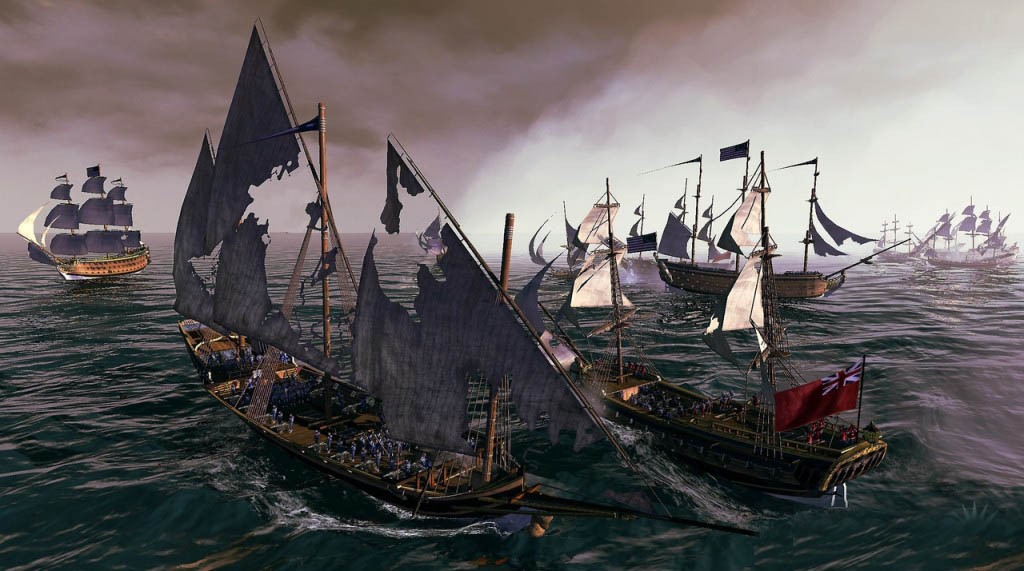
- 1645 September 9 Tamandare – Dutch squadron under Jan Lichthart destroys a Portuguese squadron under Jerônimo Serrão de Paiva at Tamandaré Brazil
- 1645 – Algerian Barbary pirates attempted an attack on Edinburgh, Scotland
- 1646 La Naval de Manila – Two Spanish galleons with Spanish & Filipino crew repel a Dutch invasion fleet in 5 separate actions over several months around the Philippines
- 1646? – French under du Mé defeat Spanish
- 1646 14–16 June, Battle of Orbetello, Spanish defeat French invasion fleet commanded by Jean Armand de Maillé-Brézé
- 1647 June 10 Puerto de Cavite – Spanish defeat Dutch attack near Manila
- 1647 Neapolitan Republic (1647)- Spanish defeat French at Ischia, Pozzuoli, and Salerno and force French out of southern Italy.
- 1650 July 26 – Minor battle between Parliamentarians and Royalists/Portuguese near Lisbon
- October 20 – Parliamentarians capture French frigate
- 1654 March 23 Colombo – Skirmish between Dutch and Portuguese
- May 2 – Dutch defeat Portuguese near Colombo
- 1655 – English naval bombardment of Algiers
- 1655 April 14 – English under Robert Blake destroy Barbary ships at Porto Farina, northern Tunisia
- – French under Vendôme defeat Spanish near Barcelona
- 1657 April 20 – Santa Cruz de Teneriffe – English under Blake defeat Spanish
- September 12 and 13 – Danes and Swedes fight inconclusively near Moen, Denmark
- 1658 November 8 The Sound – Dutch get the better of a Swedish fleet in a large battle near Copenhagen, in support of Denmark. Danish ships watch but are unable to participate
- 1659 March 30 – Minor battle between Dutch and Danes against Swedes
- April 30 – Small running battle between Dutch and Danes against Swedes
- – Dutch/Danes under de Ruyter defeat Swedes and liberate Nyborg
- 1661 – French naval bombardment of Algiers
- 1669 December – Battle of Cádiz, English Mary Rose vs 7 Algerines
- 1670 August – English/Dutch ships defeat Algerine force near Gibraltar
- 1671 May – Privateers beat off a force of Turkish galleys near Egina, Greece
- 1675 February 11 – French under Comte de Vivonne defeat Spanish under de la Cueva near Lipari Islands, Italy
- July (possible engagement) – English defeat Tripolitans
- 1676 January 8 Stromboli (Alicuri) – Inconclusive fight between French under Abraham Duquesne vs Dutch and Spanish under Michiel de Ruyter
- January – English defeat Tripolitans
- April 22 Agosta (Etna) – French fleet under Duquesne and Dutch/Spanish fleet under de Ruyter fight to a draw. De Ruyter is mortally wounded
- June 2 Palermo – French under Comte de Vivonne defeat Dutch/Spanish under De la Cerda and Den Haen
- May 25 and 26/June 3 and 4 – Dutch/Danish fleet under Niels Iuel defeat Swedes under Baron Creutz between Bornholm and Rugen in the Baltic Sea
- June 1/11 Öland – Dutch/Danish fleet defeats Swedish fleet south of Öland in the Baltic Sea
- 1677 March 3 Tobago – French under Jean II d’Estrées are repelled by Dutch under Jacob Binckes
- May 31 and June 1/11 – Danes defeat Swedes between Femern and Warnemunde, Baltic Sea
- July 1/11 and 2 Køge Bay – Danes and Dutch defeat Swedish fleet
- December Tobago – French under Jean II d’Estrées defeat Dutch under Jacob Binckes
- 1678 – Undecided action of the isle of Ouessant between a Dutch squadron under Evertsen and a French squadron under Château-Renault
- 1679 May 3 – Danes vs Swedes
- June 26, June 28, July 2 and July 20 – Series of skirmishes culminating in a Danish victory over Sweden
- 1681 July 23 – French defeats Tripolitans
- September 30 – Spanish defeat Brandenburgers near Cape St Vincent
- 1683 – French naval bombardment of Algiers
- 1686 July 12 – Venetians attacks “Alexandria Caravan” with its Turkish and Tripolitan escort between Naxos and Nicaria
- October 4 – Venetians vs Turks near Mitylene, Greece
- c. 1687/88? – Turks and Algerines, under Mezzo Morto, defeat Venetians
- 1687–1688 – French naval bombardment of Algiers
- 1688 June 15 – Venetians attacks “Alexandria Caravan” with its Turkish and Algerian escort east of Naxos, Greece
- 1689 May 1/11 Battle of Bantry Bay – French defeat English off SW Ireland
- French vs English near Casquets
- 1690 March 26 – Turks and Algerines under Mezzo Morto defeat Venetians under Valier
- July 10 Beachy Head (Beveziers) – French defeat Anglo-Dutch fleet
- – French vs English and Dutch near Madras
- September 8 – Venetians fight the combined fleet of Turkey, Algiers, Tripoli and Tunis near Mitylene, Greece
- 1692 May 27 – June 3 Barfleur and La Hougue – Decisive defeat of French by English and Dutch in the War of the Grand Alliance
- – French defeat Spanish near Cape Finisterre
- – French defeat Tripolitans near Malta
- 1693 June Lagos Bay – French under Tourville capture 50 out of 140 merchantmen
- 1694 June 29 – French under Jean Bart defeat Dutch under Hidde de Vries and others
- 1695 February 9 and 19 – Turkish fleet defeats and then fights Venetians under Zeno
- April 16 – French defeat English
- September 15 and 18 – Venetians under Contarini vs Turks under Mezzo Morto
- 1696 (mid) – Russians vs Turks near Ochakov, Black Sea
- June 17 Dogger Bank – French defeat Dutch
- – French and English fight in Newfoundland
- – Fight near San Domingo
- July 14 Bay of Fundy – French under Pierre Le Moyne d’Iberville defeat English
- August 22 – Venetians under Contarini vs Turks and their allies under Mezzo Morto near Andros
- 1697 July 6, September 1 and September 20 – Venetians under Contarini vs Turks in a series of battles in the Aegean Sea
- 1698 September 20 – Venetians vs Turks, Tripolitans and Tunisians near Samothrace, Greece
18th century Naval Battles
- 1701 August 17 – Maltese raid on La Goulette
- 1702 August 19–24 (OS) – English under Benbow – French under Ducasse draw
- October 23 Vigo Bay – Anglo-Dutch fleet defeat French and Spanish and destroy Spanish treasure fleet
- 1703 May 22 Cap de la Roque/Bay of Biscay – French squadron attacks large Anglo-Dutch merchant fleet
- 1704 August 24 Malaga – English and Dutch under Rooke narrowly defeat French near Malaga
- 1707 October 21 The Lizard – 2 French squadrons under Forbin and Duguay-Trouin defeat British convoy and escort under Richard Edwards
- 1708 June 8 – Wager’s Action (Battle of Barú)
- 1709 March 2 – British vs French
- June 25 – Maltese defeat Tripolitans near Cape Santa di Leuca
- 1710 April 18 – Maltese defeat Algerines
- 1713 April 12 – Maltese defeat Algerines
- – Portuguese defeat Indians near Cheul
- 1716 July 8 – Venetians under Corner fight an inconclusive battle against Turks under Jannum Koggia east of Corfu
- 1717 June 12, 13, 16 and 22 – Venetians under Flangini vs Turks in northern Aegean
- July 19 Matapan – Venetians and their allies vs Turks in Gulf of Laconia, Greece
- 1718 – Portuguese defeat Indians near Karwar
- July 20–22 – Venetians vs Turks
- August 11 Cape Passaro – British under George Byng defeat Spanish near Sicily
- 1738 June 20, 28 and 29 – Russians vs Turks
- August 9 and 10 – Turks defeat Russians
Great Northern War (1700–21)
- 1702 June 26 – Small-ship action between Sweden and Russia on Lake Ladoga
- September 7 – Small-ship action between Sweden and Russia on Lake Ladoga
- 1703 August 7 – Small-ship action between Sweden and Russia on Lake Peipus
- 1704 May 17 – Small-ship action between Sweden and Russia on Lake Peipus
- 1705 June 26 – Swedish ships attack Russian base of Kotlin
- 1710 October 4 – Battle between Denmark under Gyldenløve and Sweden under Wachtmeister in Kjöge Bay
- 1712 April 11 – Danes under Knoff vs Swedes under Sjöblad
- July 31 and August 17 – Danes under Sehested fight and then defeat Swedes under Henck near Rugen
- August 4 – Very minor engagement between Russia and Sweden
- September 28 – Very minor engagement between Denmark and Sweden
- 1713 July 22 – Minor engagement between Sweden and Russia
- 1714 August 6 Gangut – Russian galleys under Apraksin defeat Swedish force
- 1715 April 24 – Danes under Gabel defeat Swedes under Wachtmeister
- 1716 July 8 Dynekilen – Danes under Tordenskjold defeat Swedes
- 1717 May 14 or 15 – Danish attack on Göteborg is defeated
- July 19 – Danish attack on Strömstad is defeated
- 1718 September 17 or 21 – Swedes under King Carl XII defeat Danes under Paulssen
- 1719 June 4 Osel Island – Russians defeat Swedes under Wrangel
- July 13 – Danes under Rosenpalm defeat Swedes at Strömstad
- 1720 August 7 Grengam – Battle between Russian galley fleet under Galitzine and Swedish sailing ships under Sjöblad. Both sides claims victory
War of the Austrian Succession (1740–48)
- 1741 January 7 and 8 – British vs French in West Indies
- February 12 – Minor British vs French in Gibraltar Strait
- March–May Cartagena de Indias – Decisive Spanish victory against a large British fleet during the War of Jenkins’ Ear
- August 10 Colachel – Raja of Travancore in India defeats Dutch naval force at Colachel
- 1742 May 31 – Swedes retreat after battle with Russians in Gulf of Finland
- 1744 February 22 Toulon (Cape Sicié) – Draw between Franco-Spanish and British fleets south of Toulon
- 1746 June 25 (OS) – British under Edward Peyton vs French under la Bourdonnais
- 1747 May 14 1st Cape Finisterre – British under Anson defeat French under de Jonquières
- October 25 2nd Cape Finisterre – British under Hawke defeat French under de l’Etenduère
- 1747/48 – French under Labourdonnais vs British under Peyton near Negapatam
- 1748 March 7 – British under Cotes defeat Spanish
- October 12 – British vs Spanish near Havana
Seven Years War (1756–63)
- 1755 June 8 Gulf of St. Lawrence – British under Boscawen defeat French under Hocquart
- 1756 May 20 Minorca – French under la Galissonnière defeat British under John Byng
- 1757 early – French under Kersaint de Coëtnempren vs British at San Domingo
- 1758 – Minor French under Duchaffault vs British under Boscawen near Ushant
- – Minor French under Durevest vs British under Saunders near Gibraltar Strait
- April 29 Cuddalore – British under Pocock defeat French under d’Ache
- August 3 Negapatam – British under Pocock defeat French under d’Ache
- 1759 August 19 Lagos – British under Boscawen defeat French under de la Clue
- September 10 – Light Swedish force defeats similar Prussian force near Szczecin
- September 10 Pondicherry – British fight French but are too damaged to pursue
- November 20 Quiberon Bay/Cardinaux – British defeat French near St Nazaire
- 1760 July 3–8 Restigouche River – British defeat French relief force
- 1762 – British attack on Spanish-held Havana
Russo-Turkish War (1768–74)
- 1770 May 27 and 28 – Russians vs Turks near southern Greece
- June 4 – Minor Russians vs Turks south of Athens
- July 5–7 Chesma – Russian fleet defeats and burns Turkish fleet off western Turkey
- 1772 November 6–8 – Russians defeat Turks west of Patrai, Greece
- 1773 July 4 – Russians under Kinsbergen vs Turks
- September 3 – Russians under Kinsbergen vs Turks
- September? – Russians vs Turks
- 1774 June 20 and July 9/19 – Russians under Tchitchagov and Seniavin vs Turks
American War of Independence (1776–83)
- 1776 October 11 Valcour Island – Benedict Arnold escapes the British fleet under Guy Carleton
- 1777 September 26 to November 16, 1777 Siege of Fort Mifflin on the Delaware River American fleets under John Hazelwood, defending Philadelphia from British navy.
- 1778 April 19 Frederica Naval Action
- July 27 First Ushant – British under Keppel with 30 ships of the line fight inconclusive action against French under d’Orvilliers with 28 ships
- 1779 July 6 Grenada
- end – French vs British under Hyde Parker near Fort Royal, Martinique
- 1780 January 16 Cape St Vincent – British under Rodney defeat Spanish under de Langara
- April 17 Martinique – British under Rodney fail to defeat French under de Guichen
- August 9 Spanish-French fleet under Luis de Córdova y Córdova captures 55 ship British convoy off Cape Santa María
- Spanish-French fleet under Luis de Córdova y Córdova captures 29 ship British convoy
- 1781 April 16 Porto Praya – French under Suffren vs British, in the Cape Verde Islands
- April 19 Fort Royal
- – Minor French under de Grasse vs British under Hood
- – Minor French under Destouches vs British under Arbuthnot
- July 21 Cape Breton Island – French attack British convoy
- August 5 (15 NS?) Dogger Bank – Draw between Dutch and British squadrons
- September 5 Chesapeake Bay – French under de Grasse drive off British under Graves
- December 12 Second Ushant – British under Kempenfelt capture part of a French convoy from de Guichen
- 1782 January 25 St Kitts – British under Hood defeat French under de Grasse
- February 17 Sadras – First fierce but indecisive fight between French under Suffren and British under Hughes near south-east India
- April 9 and 12 The Saintes – British under Rodney decisively defeat French under de Grasse in the West Indies
- April 12 Providien – 2nd fight between Suffren and Hughes off India
- April 21 – British defeat French
- July 6 Negapatam – 3rd fight between Suffren and Hughes off India
- September 3 Trincomalee – Hughes fleet damages Suffren’s but withdraws
- October 20 Cape Spartel – Franco-Spanish fleet under Luis de Córdova y Córdova fights British fleet under Richard Howe in indecisive battle. Howe resupplies Gibraltar
- 1783 June 20 Cuddalore – Suffren prevents Hughes seizing Cuddalore. Last of the five battles between Suffren and Hughes
Russo-Turkish War (1787–92)
- 1787 August 30 – Russians vs Turks
- September 27, 28 and 30 – Russians vs Turks
- October 15 – Russians defeat Turks
- 1788 June 17, 18, 28 and 29 and July 9 – Russian and Turkish land and sea forces clash near Ochakov
- July 14/25 Ochakov – Russia defeats Turkey near Fidonisi
- 1789 June 2–4 – Russians defeat Turks at Sinope
- 1790 July 19 Kerch Strait – Slight Russian victory over Turks
- September 8 and 9 Tendra – Russians defeat Turks
- October 31 – Russians defeat Turks at the Sulina mouth
- November 17, 18 – Russians defeat Turks at Tultcha
- November 29 – Russians defeat Turks at Ismail
- November 30, December 1, 2, 4–7 – Russians defeat Turks
- 1791 July 9 Matchin – Russians defeat Turkish rowing vessels
- August 11 Cape Kaliakra – Slight Russian victory over Turks in a largely inconclusive battle near Bulgaria
Russo-Swedish War (1788–90)
- The Russian calendar was eleven days behind the Swedish during the 18th century, so Russian dates are eleven days earlier.
- 1788 July 17 (July 6 OS) Hogland – Bloody engagement between Swedish and Russian battlefleets. Both sides lose a ship, but Swedes withdraw
- 1789 July 26 (July 15 OS) Öland – Indecisive action between the Swedish and Russian battlefleets.
- August 24 and 25 (August 13 and 14 OS) First Svensksund/Ruotsinsalmi in Finland – Russian galley flotilla decisively defeats Swedes.
- September 18 (September 7 OS) – Russians defeat Swedes in a small battle in Barösund near Inkoo in Finland.
- 1790 May 13 (May 2 OS) Reval – Disastrous Swedish attack on Russian battlefleet at Reval (now Tallinn).
- May 15 (May 4 OS) Fredrikshamn/Hamina in Finland – Swedish galley flotilla defeats Russian galley flotilla.
- June 3 and 4 (May 23 and 24 OS) – Action off Kronstadt – Indecisive action between the battlefleets.
- July 3 (June 22 OS) Vyborg Bay – The Swedish battlefleet and galley flotilla break through the Russian blockade, suffering heavy losses.
- July 9 and 10 (June 28–29 OS) Second Svensksund/Ruotsinsalmi in Finland – Decisive victory of the Swedish galley flotilla. The largest naval battle in the Baltic Sea of all times. Extremely heavy losses suffered by the Russians.
French Revolutionary War (1793–1802)
- 1793 November 6 – French capture HMS Alexander
- November 18 – Short, inconclusive British-French battle
- 1794 January 22 and 25 – French attack British convoy
- April 23 – British defeat French frigates
- June 1 The Glorious First of June – British fleet defeats French fleet in North Atlantic but French grain convoy makes it through to Brest
- June 8 – French vs British near Jersey
- August 23 – British defeat French near Brest
- October 22 – French vs British near Mauritius
- 1795 March 13 and 14 – British under Hotham vs French under Martin
- June 8 and 9 – British vs French near Belle Isle
- June 23 Groix – British under Hood defeat French under Villaret-Joyeuse off Groix, France
- July 13 – British vs French
- October 7 – British vs French
- 1797 February 14 Cape St Vincent – British under Jervis defeat Spanish near Gibraltar
- March 26 – Austrian vessels, supported by Venetian battleship, fight off small French attack
- May 16 – Danish vessels get the better of Tripolitans near Tripoli, Libya
- October 11 Camperdown (Kamperduin) – British fleet under Admiral Duncan defeats Dutch
- 1798 August 1–3 The Nile (Aboukir Bay) – British under Nelson defeat moored French fleet under Brueys in Egypt
- October 12 – British defeat French invasion force off western Ireland
- October 28 – Minor British vs French
- 1799 September 3, 4, 5 and 10 – Minor light skirmishes between British and Spanish
- 1800 August 4 – French attack British convoy
- 1801 April 5 Copenhagen – British under Nelson destroy moored Danish ships off Copenhagen to prevent France taking them over
- July 6–12 Algeciras – French defeat initial British assault, British counter-attack and defeat Franco-Spanish force.
Naval Battles of the Industrial era

Crimean War 1855
Boshin war 1860s
Civil War 1861
Lissa 1866
Yalu 1894
The 1898 war
Santiago July 1898
Manila June 1898
Tsushima
Trafalgar ushered in the Pax Britannica of the 19th century, marked by general peace in the world’s oceans, under the ensigns of the Royal Navy. But the period was one of intensive experimentation with new technology; steam power for ships appeared in the 1810s, improved metallurgy and machining technique produced larger and deadlier guns, and the development of explosive shells, capable of demolishing a wooden ship at a single blow, in turn required the addition of iron armour.
Although naval power during the Song, Yuan, and Ming dynasties established China as a major world seapower in the East, the Qing dynasty lacked an official standing navy. They were more interested in pouring funds into military ventures closer to home (China proper), such as Mongolia, Tibet, and Central Asia (modern Xinjiang). However, there were some considerable naval conflicts involving the Qing navy before the First Opium War (such as the Battle of Penghu, and the capture of Formosa from Ming loyalists).
The Qing navy proved woefully undermatched during the First and Second Opium Wars, leaving China open to de facto foreign domination; portions of the Chinese coastline were placed under Western and Japanese spheres of influence. The Qing government responded to its defeat in the Opium Wars by attempting to modernize the Chinese navy; placing several contracts in European shipyards for modern warships. The result of these developments was the Beiyang Fleet, which was dealt a severe blow by the Imperial Japanese Navy in the First Sino-Japanese War (1894–1895).
The battle between CSS Virginia and USS Monitor in the American Civil War was a duel of ironclads that symbolized the changing times. The first fleet action between ironclad ships was fought in 1866 at the Battle of Lissa between the navies of Austria and Italy. Because the decisive moment of the battle occurred when the Austrian flagship Erzherzog Ferdinand Max successfully sank the Italian flagship Re d’Italia by ramming, in subsequent decade every navy in the world largely focused on ramming as the main tactic. The last known use of ramming in a naval battle was in 1915, when HMS Dreadnought rammed the (surfaced) German submarine, U-29. The last surface ship sunk by ramming happened in 1879 when the Peruvian ship Huáscar rammed the Chilean ship Esmeralda. The last known warship equipped with a ram was launched in 1908, the German light cruiser SMS Emden.
With the advent of the steamship, it became possible to create massive gun platforms and to provide them with heavy armor resulting in the first modern battleships. The Battles of Santiago de Cuba and Tsushima demonstrated the power of these ships.
Bolivarian wars of independence:
-Battle of Sorondo on the Orinoco in Venezuela in 1812: Spanish victory over the insurgents.
-Battle of Lake Maracaibo (1823): Revenge of Venezuela over Spain.
-Battle of Port-Del Buceo (1814): In the Rio de la Plata, the Argentinians destroy a Spanish squadron.
Columbia and American War 1813-1815:
-Battle of Lake Erie (1813): American Victory.
-Battle Lake Champain (1814): Same scenario.
War in the Balkans, Greek Independence:
-Battle of Chios (1822): Greek victory against the Turks.
-Battle of the Bay of Suda (1825): Greek victory against a Turkish-Egyptian coalition.
-Battle of Navarino (1827): Victory coalition of British, French and Russians on Turkish-Egyptian fleet.
Cisplatin War (River Plata):
-Battle of Los Pozos (off Buenos Aires, 1826): Argentina win against Brazil.
-Battle-Lara-Quilmes (1826): Same scenario.
-Battle of Juncal (off Uruguay, 1827): Same.
-Battle of Vila del Carmen (coast of Patagonia, 1827): Same.
-Battle of Monte Santiago (1827): Brazil’s Revenge.
War of Great Colombia
-Battle of Malpelo (1828): Victory against the Peruvian Gran Colombia
-Battle of Cruces (1828): Same scenario.
Russo-Turkish War of 1828:
-Battle of Braila: Russian Victory.
Portuguese Civil War:
-Battle of Vila da Praia (Azores, 1829): Victory of the Liberals on the absolutists.
-Battle of Cape St Vincent (Gibraltar, 1833): Same scenario.
Peruvian-Chilean War:
-Battle of Islay (Pacific, 1838): Combat undecided.
-Battle of Casma (Pacific, 1839): Chilean victory.
Insurrection in Yucatan
-Battle of Campeche (1843): Victory insurgents Yucatan and the Mexican Texans.
Franco-Vietnamese conflict:
-Battle of Tourane (1847): French victory over the fleet Thai imposing French colonial rule for a hundred years.
Crimean War (1853-1855):
-Battle of Pitsunda (1853, black sea coast of Georgia): Russian victory over the Turks.
-Battle of Sinope (1853, Black Sea): Same scenario.
American Civil War (1861-1865)
-Battle of Hampton Roads (1862, coast of Virginia): Combat undecided between Virginia and Monitor.
-Battle of Memphis (1862, Shelby County, Battle River): Union victory.
-Battle of Cherbourg (1864): Fighting between CSS Alabama and USS Kearsarge and win it.
-Battle of Mobile Bay (1864, coasts of Alabama): Union victory.
War of Duchies:
-Battle of Eckenford (1864): Prussian victory over the Danes
-Battle of Rügen (1864, Baltic): Danish victory over the Prussians.
-Battle of Heligoland (1864, North Sea): Danish victory over a Prussian-Austrian coalition.
War of the Triple Alliance:
-Battle of Riachuelo (Rio Prana, Paraguay, 1865): Brazilian victory over Paraguay.
War of the South Pacific:
-Battle of Papudo (Valparaiso, 1865): Chilean victory over Spain.
-Battle of Abtao (islands Chiloe, 1866): Peruvian-Chilean victory over Spain.
-Battle of Callao (peruvian Coast, 1866): Victory in Peru to Spain.
Austro-Italian War:
-Battle of Lissa (Adriatic, 1866): Austro-Hungarian victory over Italy.
Boshin war:
-Battle of Hakodate (1869): Victory of the Imperial fleet in the fleet of the Republic of Ezo.
Franco-Prussian War of 1870:
-Combat in Havana (1870): Combat undecided between the gunboats and Bouvet Meteor.
War in the South Pacific:
-Battle of Chipana (1879): Combat undecided between Peruvian and Chilean corvettes.
-Battle of Iquique (1879): Win two ships including a battleship Peruvians against two Chilean ships. The same day, one of the Peruvian vessel was then routed by a Chilean unit in Punta cranes.
-Battle of Angamos (1879): Chilean contrast with a whole squadron deployed against the battleship Huascar.
Franco-Chinese War of 1883:
-Battle of Foochow (1884): French squadron victory of the Chinese fleet.
-Battle of Shei-Poo (1885): French torpedo boats against two Chinese frigates which destroyed one another.
Sino-Japanese War of 1894:
-Battle of Fengdao (1894): Japan’s victory over Chinese units. -Battle of Weihaiwei (1894): Japanese victory over a Chinese fleet. -Battle of Yalu (1895): Same scenario.
Spanish-American War of 1898:
-Battle of Manila Bay (Cavite): American victory over a Spanish fleet at anchor.
-Battle of Cardenas (Cuba): Battle between three and five American Spanish gunboats. Spanish victory.
-Battle of Santiago de Cuba: American victory over the Spanish squadron in Cuba.
WW1 Naval battles
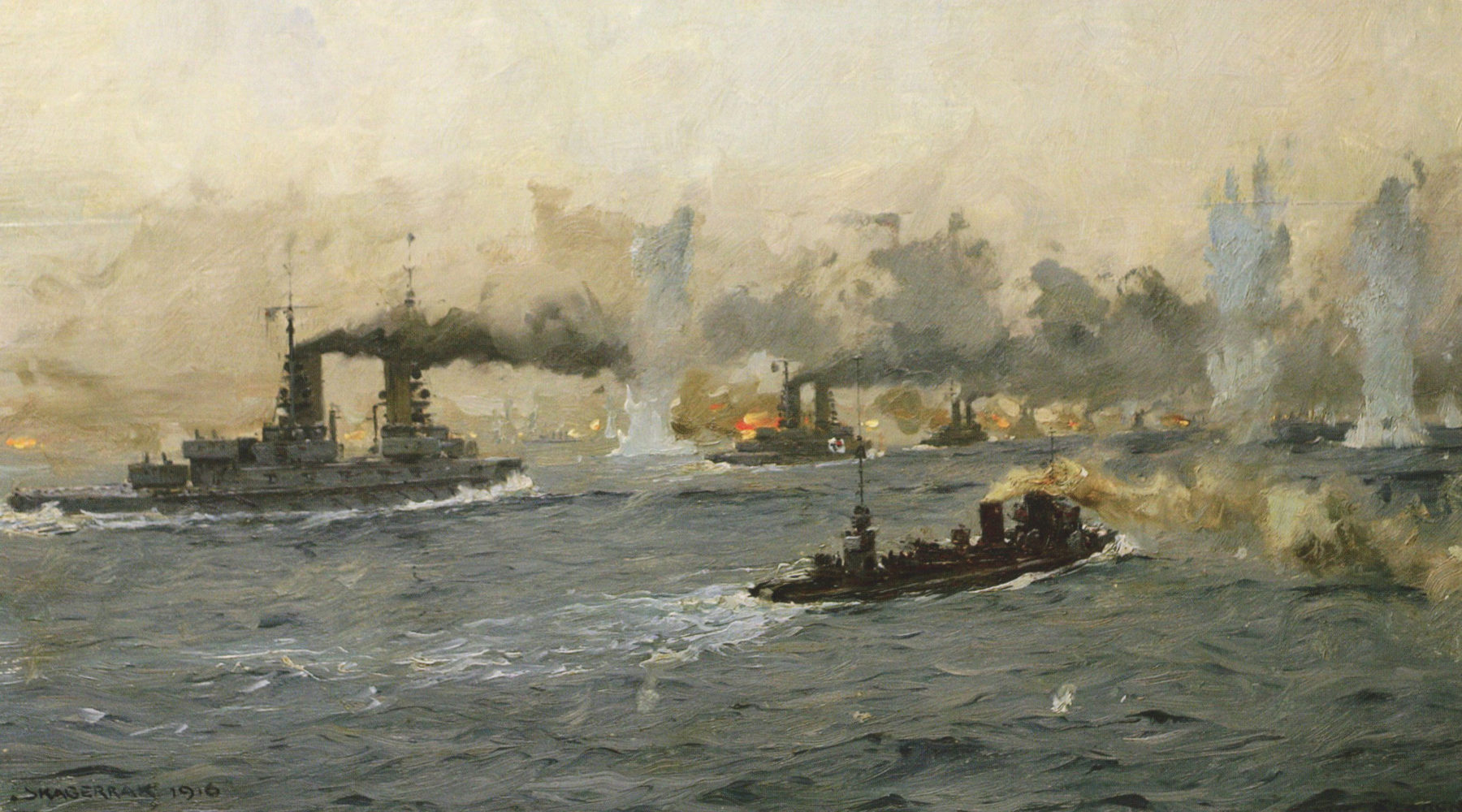
This chapter encompasses the pre-WWI smaller wars that orecluded the use of modern vessels since the Russo-Japanese war, but will also in the future, encompass Naval battles and actions of the Russian Civil war. Covered so far:
Elli & Lemnos (1912-13)
Königin Luise attack (1914)
Souchon Escape (1914)
Antivari (1914)
Heligoland (1914)
Odensholm (1914)
Tsingtao (1914)
Cape Sarytch (1914)
Coronel (1914)
Falklands (1914)
Gotland (1915)
Emden’s Odyssey (1915)
Lake Tanganyika (1915)
Dardanelles (1915)
Lusitania (1915)
Adriatic (1915-18)
Dover Strait (1916-17)
Jutland (1916)
Moon Island (1917)
Otranto Strait (1917)
Heligoland (1917)
Imbros (1918)
Zeebruge raid (1918)
WW2 Naval battles
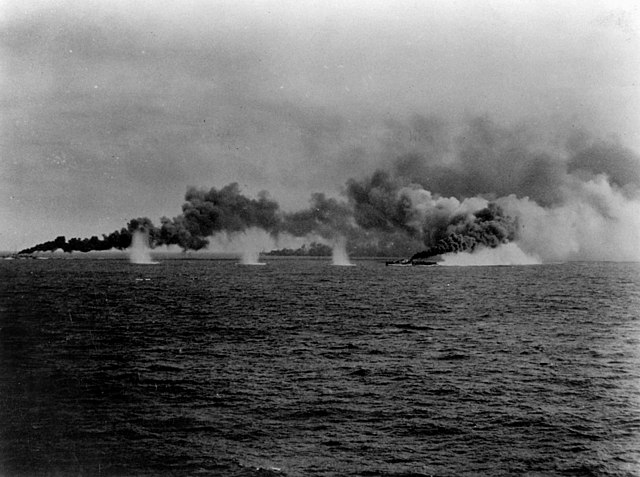
This section is dedicated to the second world war naval battles, 1939-1945. The conflict was global on even a larger reach geographically (like the asian and pacific front) and fleets were way more balanced, naval battles and campaigns, including amphibious operations or the intensity of the battle of the Atlantic and new theaters of operations.
- Summary:
- Schleswig-Holstein in Dantzig (1er Septembre 1939)
- Graf Spee raid (13-19 dec. 1939)
- Norwegian campaign (april 1940)
- Mers-el-Kebir (6 july 1940)
- Battle of Punta Stilo (9 july 1940)
- Tarento raid (11-12 nov. 1940)
- Cape Matapan (27-28 mars 1941)
- Battle of Kerkenna (16 april 1941)
- Bismarck raid (18-27 may 1941)
- Battle of Crete (may 1941)
- Bataille of the Atlantic (1939-45) Main article
- Great Syrta battle (22-23 march 1942)
- Pantelleria (15 june 1942)
- Operation “Pedestal” (11-12 aug. 1942)
- Italian specs ops and Flotilla X-Mas (1940-43)
- British Amphibious operations and ships (portal)
- Axis amphibious ships and landings (German and Italian)
- Malta’s axis invasion plan (Operation Herkules/C3)


 Latest Facebook Entry -
Latest Facebook Entry -  X(Tweeter) Naval Encyclopedia's deck archive
X(Tweeter) Naval Encyclopedia's deck archive Instagram (@navalencyc)
Instagram (@navalencyc)





 French Navy
French Navy Royal Navy
Royal Navy Russian Navy
Russian Navy Armada Espanola
Armada Espanola Austrian Navy
Austrian Navy K.u.K. Kriegsmarine
K.u.K. Kriegsmarine Dansk Marine
Dansk Marine Nautiko Hellenon
Nautiko Hellenon Koninklije Marine 1870
Koninklije Marine 1870 Marinha do Brasil
Marinha do Brasil Osmanlı Donanması
Osmanlı Donanması Marina Do Peru
Marina Do Peru Marinha do Portugal
Marinha do Portugal Regia Marina 1870
Regia Marina 1870 Nihhon Kaigun 1870
Nihhon Kaigun 1870 Preußische Marine 1870
Preußische Marine 1870 Russkiy Flot 1870
Russkiy Flot 1870 Svenska marinen
Svenska marinen Søværnet
Søværnet Union Navy
Union Navy Confederate Navy
Confederate Navy Armada de Argentina
Armada de Argentina Imperial Chinese Navy
Imperial Chinese Navy Marinha do Portugal
Marinha do Portugal Mexico
Mexico Kaiserliche Marine
Kaiserliche Marine 1898 US Navy
1898 US Navy Sovietskiy Flot
Sovietskiy Flot Royal Canadian Navy
Royal Canadian Navy Royal Australian Navy
Royal Australian Navy RNZN Fleet
RNZN Fleet Chinese Navy 1937
Chinese Navy 1937 Kriegsmarine
Kriegsmarine Chilean Navy
Chilean Navy Danish Navy
Danish Navy Finnish Navy
Finnish Navy Hellenic Navy
Hellenic Navy Polish Navy
Polish Navy Romanian Navy
Romanian Navy Turkish Navy
Turkish Navy Royal Yugoslav Navy
Royal Yugoslav Navy Royal Thai Navy
Royal Thai Navy Minor Navies
Minor Navies Albania
Albania Austria
Austria Belgium
Belgium Columbia
Columbia Costa Rica
Costa Rica Cuba
Cuba Czechoslovakia
Czechoslovakia Dominican Republic
Dominican Republic Haiti
Haiti Hungary
Hungary Honduras
Honduras Estonia
Estonia Iceland
Iceland Eire
Eire Equador
Equador Iran
Iran Iraq
Iraq Latvia
Latvia Liberia
Liberia Lithuania
Lithuania Mandchukuo
Mandchukuo Morocco
Morocco Nicaragua
Nicaragua Persia
Persia San Salvador
San Salvador Sarawak
Sarawak Uruguay
Uruguay Venezuela
Venezuela Zanzibar
Zanzibar Warsaw Pact Navies
Warsaw Pact Navies Bulgaria
Bulgaria Hungary
Hungary

 Bundesmarine
Bundesmarine Dutch Navy
Dutch Navy Hellenic Navy
Hellenic Navy Marina Militare
Marina Militare Yugoslav Navy
Yugoslav Navy Chinese Navy
Chinese Navy Indian Navy
Indian Navy Indonesian Navy
Indonesian Navy JMSDF
JMSDF North Korean Navy
North Korean Navy Pakistani Navy
Pakistani Navy Philippines Navy
Philippines Navy ROKN
ROKN Rep. of Singapore Navy
Rep. of Singapore Navy Taiwanese Navy
Taiwanese Navy IDF Navy
IDF Navy Saudi Navy
Saudi Navy Royal New Zealand Navy
Royal New Zealand Navy Egyptian Navy
Egyptian Navy South African Navy
South African Navy






























 Ukrainian Navy
Ukrainian Navy dbodesign
dbodesign